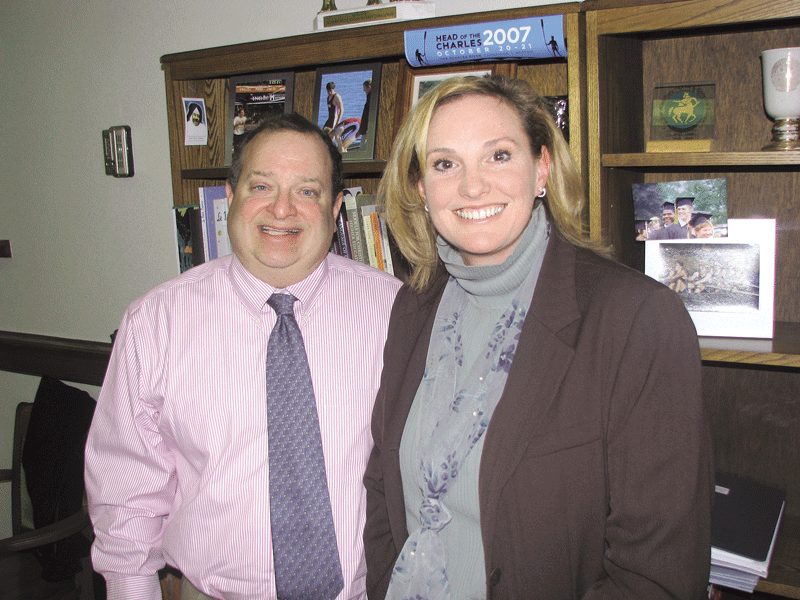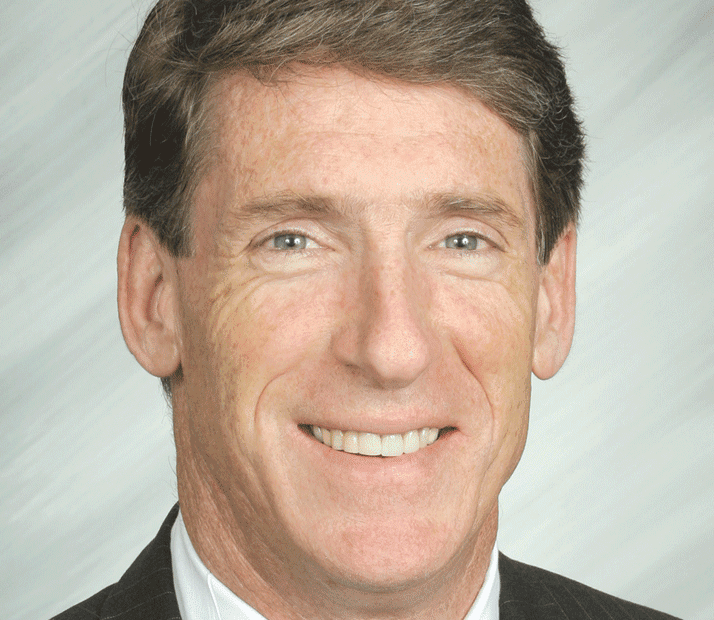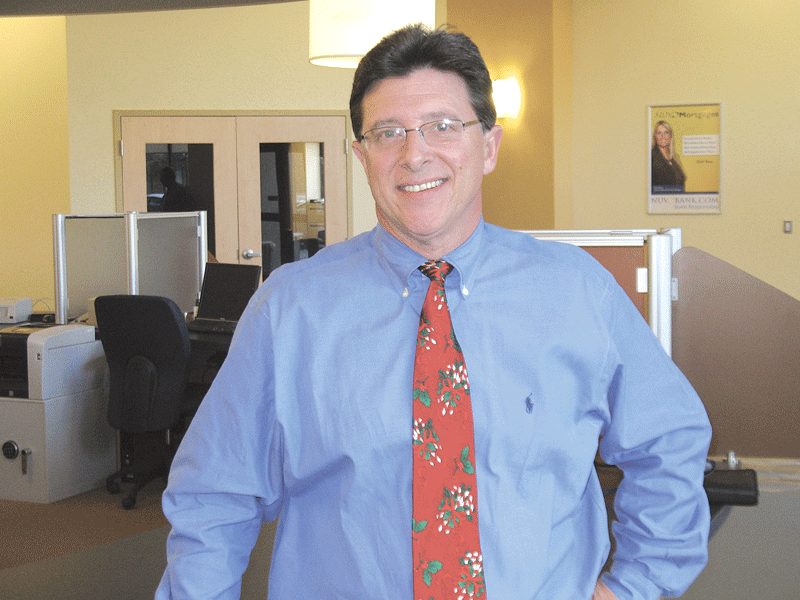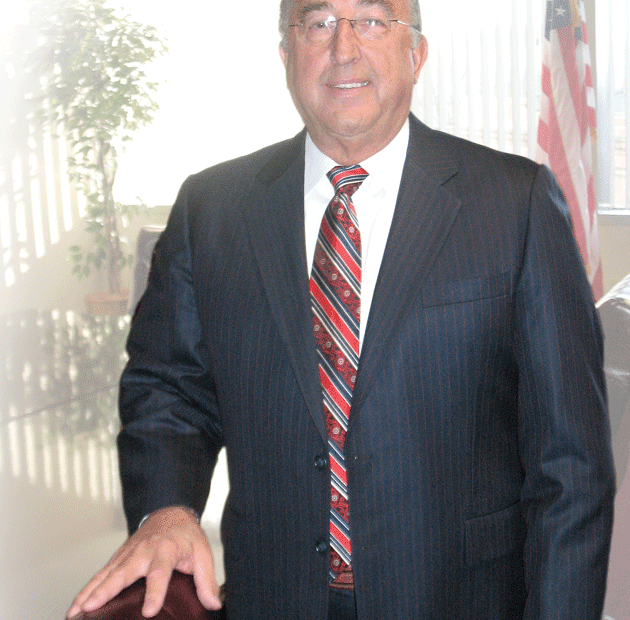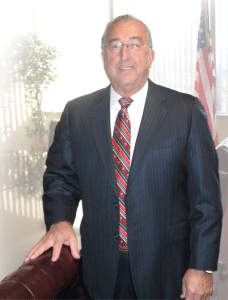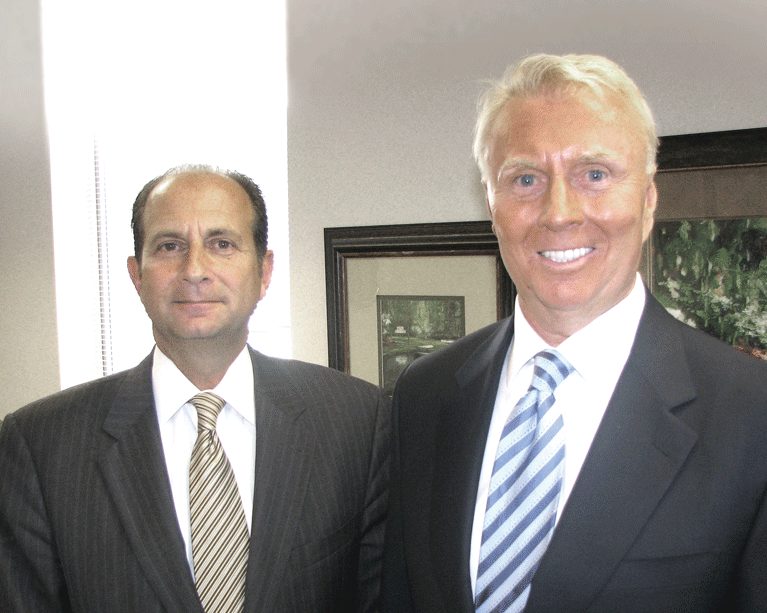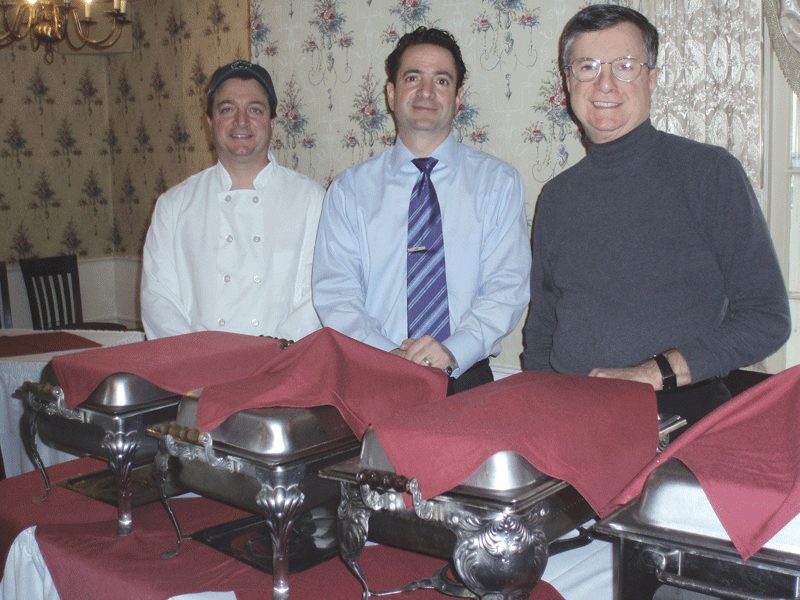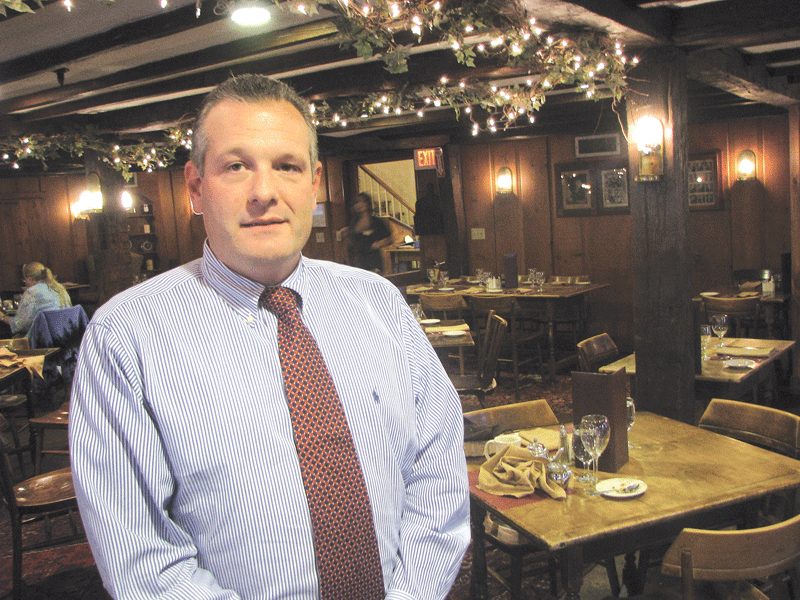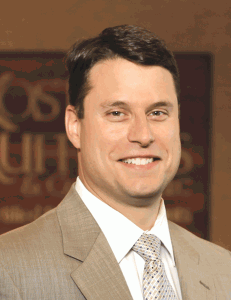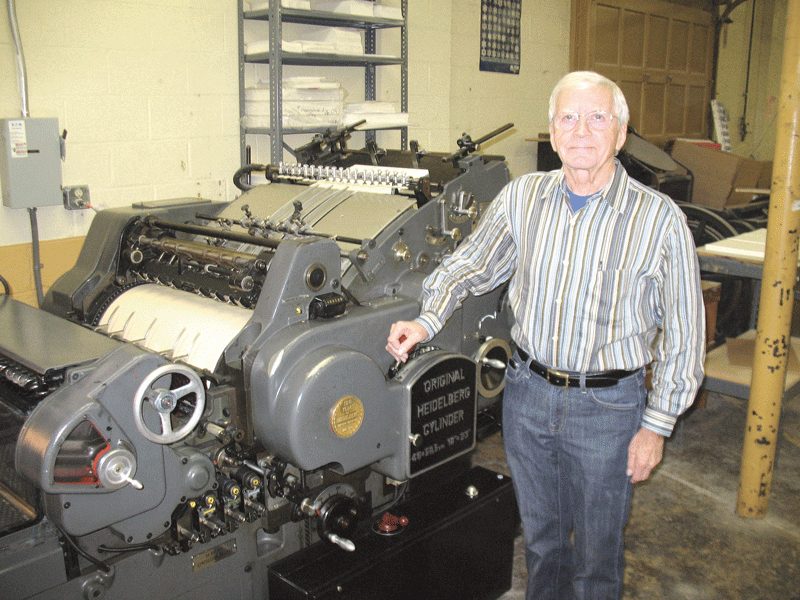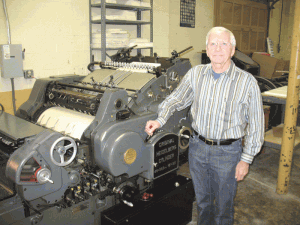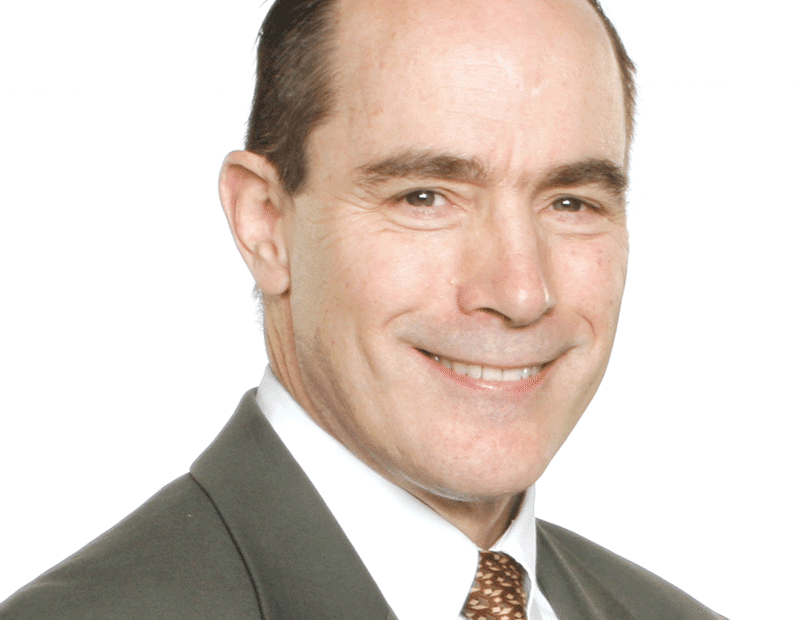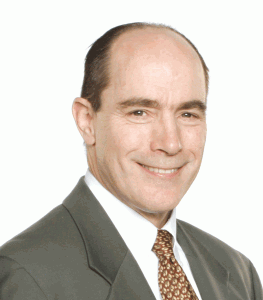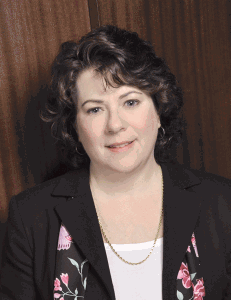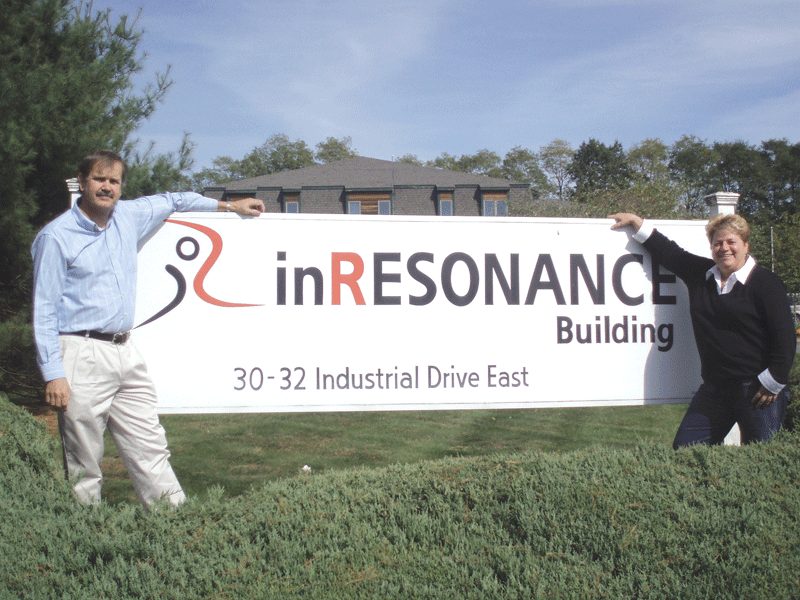Supplements
Willie Ross Continues to Set the Tone in Education for the Deaf

Willie Ross School for the Deaf Executive Director Louis Abbate says people from school districts around the world have visited the campus to find out how it has been able to establish and maintain a ‘school within a school’ partnership with the East Longmeadow school system.
“The school was founded in 1967 by a group of parents who were pioneers in the field of education,” said Executive Director Louis Abbate, adding that an epidemic of rubella in the early ’60s caused many children to be born deaf. “They were led by Willie’s parents, Barbara and Gene Ross, at a time when all deaf children went to residential schools. It was a very bold step, because a day program for deaf children was something that was unheard of. But these parents wanted their children home so they could be part of the family.”
Since that time, Willie Ross has continued to forge ahead in the field of education for the deaf with a number of innovative programs that have served as a model for other schools of its kind. They include an integrated approach to communication, frequent examination of its instructional approach, and the acknowledgement and understanding that students with hearing loss from different backgrounds and cultures have different needs best met by a multitude of options to ensure that they get the best education possible and become productive members of society.
For this edition, BusinessWest takes an indepth look at what Willie Ross has done to stay at the forefront and inspire other schools for the deaf and hard of hearing, not only in this country, but across the world.
First Steps
In the beginning, the school’s founders rented self-contained space within public-school classrooms.
“The parents of these deaf children wanted them in a hearing setting,” said Abbate. “This was a bold first step because no one in the history of special education thought it was a good idea or even possible. But they wanted to integrate their children.”
The founders faced many challenges, as they had to develop a curriculum and were on uncharted ground. But they were able to pool their resources and, in 1967, purchased the old Norway School in Longmeadow for $27,000. “The school had been built in 1917 and was quite dilapidated. But the lot included three acres and another building,” Abbate said.
These parents were active advocates for their children in the early ’70s, and their program had made such progress that local public schools began sending students with hearing deficiencies to Willie Ross. The state paid their tuition because the school was a nonprofit. In 1974, a shift came due to the adoption of Chapter 776, which shifted the responsibility of educating students with special needs from the state to the local community.
“There was a big push toward mainstreaming in 1974, which really began to give children with disabilities the right to a quality education,” Abbate explained. “And at that point, the school began to roll forward.”
However, since Willie Ross had always rented classroom space in public schools, it had enough experience to recognize that, “although it was our legacy to find opportunities for mainstreaming, it was not what some students needed. So we also offered a center-based model,” Abbate said. They also had rented classroom space for elementary students in East Longmeadow schools, for middle-school students in Longmeadow, and for high-school students in Longmeadow, and at the old William Dean Technical High School in Holyoke.
Abbate was hired in 1985, and he developed a partnership with officials in the East Longmeadow school system that he says was unique in the U.S. at that time.
“It took time, but it is amazing,” he said, noting that all students in public schools were moved to East Longmeadow, giving them the opportunity to make friendships that could continue throughout their schooling.
“It’s very interesting that, over the past 20 years, an entire generation has grown up with deaf students. They have developed wonderful friendships in an extremely welcoming and supportive environment,” Abbate said, adding that many students and East Longmeadow staff members have taken sign-language courses offered by Willie Ross.
The system developed by the partnership offers immersion and inclusion as a service for deaf and hard-of-hearing students when it is appropriate. East Longmeadow agreed that the students could be mainstreamed, with the caveat that Willie Ross would provide interpeters and staff to teach the classes. Willie Ross also does consultations for East Longmeadow students who have hearing loss.
In fact, the system of shared resources works so well that, although Willie Ross has students from 19 school districts, it has never had one from East Longmeadow.
“We were able to keep our corporate soverigenty even though we were in the public schools, as both systems worked cooperatively; everything was worked out legally to make it an optimal experience for all students,” Abbate explanined. “Because we can offer our students two campuses, we can provide them with a wide range of opportunities. It is all about changing our business plan to respond to the changing needs of students, which is what we have always tried to do.”
The system has been so successful that it has become a model that others strive to emulate.
“Within the last three years, we have had visitors from South Africa, China, India, Taiwan, and Trinidad who came to see how it is possible to link public-school opportunties with a private school. People can’t imagine how a program like ours can work,” Abbate said, adding that one obstacle is that private schools are concerned about their institutional identity, while the notion of having a school inside a school seems like an insurmountable challenge to many public schools.
“But I think this is the model of the future and is a very good use of physical resources,” Abbate said, adding that he recently met with officials from the Washington D.C. public school system as part of ongoing efforts at Willie Ross to help other schools across the nation establish satellite programs.
A trustee committee oversees the partnership. “They are committed to children, and the fact that this school was founded by parents gives us a different view,” Abbate said. “The fact that a group of parents were so committed to their children that they built a school for them is a legacy that needs to be rejuvenated and change as kids change. It’s part of the reason why we are one of the only schools in the country for the deaf which has a campus inside a public school. We look at ourselves as heirs of the legacy of our founders, as our philosophy is to educate one child at a time.”
Five years ago, the school revisted its mission and instituted an outreach and early-intervention team. Not only did they realize it was important to serve students as early as possible, children’s needs were changing due to advanced technology, which includes cochlear implants, surgically implanted electronic devices that can provide a sense of sound to people who are profoundly deaf or severely hard of hearing.
In addition, an increasing number of students came from homes where English isn’t the primary language. So administrators assembled a team of three leading educators of the deaf and worked with them to develop a new mission, which reflects the contemporary needs of their students.
“We came to the conclusion that one size doesn’t fit all, which meant more recognition of the value of different approaches,” Abbate said, adding that this is highly ununsual for a school that serves the deaf and hard of hearing. “We started out as an oral school, saw its limitations, introduced sign language in addition to voice, and continue to use both modalities,” he said.
Meeting operational costs is a challenge, however, even though the school’s teachers work at well below the public-school rate. “Our revenue is dependent on tuition from students, and the state has frozen the rate. This year it only went up 0.75%. Plus, we are not eligible for any stimulus money which poured into the state for public schools,” Abbate said.
But administrators continue to forge ahead with programs and modes of learning to best serve their students.
“We have been able to do a lot, but it is primarily due to the generosity of the community. They are very supportive of us, and we rely on their help more and more,” Abbate said. “We have three goals for our students — competitive employment, sheltered employment, or college. Most schools of our size only concentrate on one of these goals, so it is a lot for us to do. But having our East Longmeadow partnership is an enormous opportunity for our students.”
New Opportunities
The school recently completed a campus-enhancement project, which involved purchasing an overgrown acre of land adjacent to the property and developing it to enhance programs for students.
The new West Campus will be used for recreational, instructional, and athletic programs, as well as for school activities. It boasts an outdoor classroom, a walking/fitness track, a nature trail, an honor garden with plaques that celebrate deaf people who have made significant contributions to improve the lives of their peers, a basketball court, and playing fields.
The $500,000 project, funded by a capital campaign, also features a new multi-purpose room which will help the school provide more sophisticated services to students with cochlear implants and expand transition services for students graduating from high school.
Abbate said the school plans to have an after-school and summer program, and he’s happy that the board and staff members had the vision to look at the land “which was completely overgrown and littered with trash” and see its potential for their population of students, who range in age from 3 to 22. They went ahead with their vision when the land became available, and staff and students participated in decisions, such as choosing the deaf individuals who are commemorated on plaques in their Deaf Honor Garden.
“We are a nonprofit school, and it has always been a challenge to operate with limited resources, so I am grateful for the support and proud of what we will be able to offer students,” Abbate said. “The outdoor classroom puts us in the forefront of research-based education, and the property combines instructional and recreational opportunities that weren’t available before. It is a wonderful feeling to know that generations of students will be able to enjoy it.”
Elms College to Introduce M.B.A. with Three Concentrations
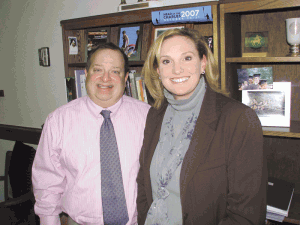
David Kimball and Kerry Calnan say the new M.B.A. program at Elms College, slated to start in the fall, provides a solid growth opportunity for the school.
Kerry Calnan acknowledged there was already a crowded field when it came to M.B.A. programs being offered in this region — before Elms College decided to enter the mix with three offerings slated to make their debuts this fall.
To stand out in this field, programs have to be somewhat unique, provide intrinsic value to students, provide the skills needed in the modern workforce, and address the many changes that are taking place in the broad realm of graduate programs in business administration, said Calnan, director of the program, who believes that Elms has all that covered, convincingly.
“M.B.A students are younger, less likely to come from disciplines other than traditional business disciplines, and expect course-delivery methods that go beyond the traditional classroom model,” said Calnan, an accounting professor at the college. “Elms College’s M.B.A. will provide the flexibility and accelerated delivery expected by today’s students.”
Elaborating, Calnan said the new M.B.A. program will offer concentrations in accounting, health care leadership, and management, and will be delivered in an accelerated hybrid format, with 11-week terms that allow students to combine online and on-campus classes, or take the entire program online. The program also features a community-service component to engage students in solving business problems within their own community.
Looking at the sum of these parts, meaning the concentrations, community work, and other components, Walter Breau, vice president of Academic Affairs at Elms, said the 82-year-old college is “taking its foundational strengths and building on them.
“I’m always looking for strategic initiatives to move forward,” he continued. “We have very high-quality programs and a great reputation in the health care field, in nursing, autism, and other areas, and I see the business area as another center of high quality where we can leverage what we have into future programming.”
Noting that a high percentage of Elms students stay in this region upon graduation, Breau said the M.B.A. is considered another opportunity to “educate young people and keep them in the Pioneer Valley.”
Administrators are projecting, conservatively, that each concentration will attract at least 10 students for the fall semester, and they wouldn’t be surprised if that number is easily exceeded.
“The feedback we’ve been getting is tremendous,” said David Kimball, chair of the college’s Business and Law Division. “The Facebook inquiries have been off the charts, with alumni being very interested; some were in accounting, others want health care leadership … all three tracks are drawing interest.”
For this issue, BusinessWest takes an in-depth look at Elms’ new offerings, how school leaders believe they will advance the college’s mission, and why they believe these offerings will stand out in that increasingly crowded field.
Course of Action
Kimball told BusinessWest that M.B.A. programs have been talked about at the Elms for some time now. And often the discussions involved the school’s business and accounting students who were enjoying, and appreciating, their undergraduate experience at the Elms and asking if they could continue on there.
“As they would approach graduation, our students would ask about graduate programs they could do on campus,” he said, adding that these queries provided not only inspiration, but evidence of a solid core of potential students. “So there will be some retention of those students who want to stay and enjoy their experience here.”
For a number of reasons that he would articulate, Breau said school administrators and the board of directors decided that the time was simply right to forge ahead with a multi-faceted M.B.A. program.
Several factors played into this decision that the timing was right, said Breau, listing everything from the school’s strong track record in placing students in graduate programs, to changes in the accounting field (individuals are not being hired by most firms unless they have completed 150 credits of work, or a fifth year of education), to an expansion of the region’s health care sector and the subsequent need for more individuals with advanced degrees.
“Health care needs are only increasing here in Western Mass., and we have some tremendous health care facilities in this area,” he explained. “I see our program helping any of the health care enterprises in this region moving forward, because leadership is becoming an increasingly important component, and these institutions are looking for ways to not only keep their people but help them move up the ladder.”
As they moved forward with its M.B.A initiative, Elms administrators sought feedback from local business leaders in order to ensure that the offerings would provide the educational background and help develop the skills needed to succeed in today’s changing workplace, said Calnan.
“There’s an increasing need for advanced education in order to be more effective in the workplace, and our program fits the needs of the market,” she explained, adding that Elms administrators were influenced, and motivated, by acknowledged changes in graduate business administration degrees, as outlined in the popular book on that subject, Rethinking the M.B.A.
“Today’s M.B.A.s are very different from those in the past,” she noted. “We need to develop programs that will meet this new need, rather than continue on with the old philosophy of what an M.B.A. should look like.
“Today, you don’t see people from other disciplines, like engineering, getting into M.B.A. programs, at least as much as you once did,” she continued. “Now, it’s generally a business student, and they’re doing it when they’re much younger and with much less experience than they had in the past. So this program tries to blend both pieces, meaning the older, traditional approach and the new approach, along with a hybrid delivery.”
Calnan said one of the distinctions of the program, and a facet that will add value and thus drive enrollment, will be its faculty, most of whom are practitioners and experts from area businesses and nonprofits.
“We have a strong commitment to excellence, and we’ve worked very hard going after top executives in all fields to be a part of this program, and in two different ways,” she explained. “First, in an advisory capacity, and then as instructors, or partners with current instructors.
“For example, there’s a course in global political economy and its impact on social and ethical responsibility,” she continued, “and it will be taught primarily by a corporate mergers and acquisitions person from MassMutual, and it will be partnered with our own Theology department, where one of our professors will co-facilitate all of the discussions during the 11 weeks. So by partnering with corporate business and community members to be involved in delivering the program, as well as advising us as a college on curriculum and important trends going on in the world of business, those two pieces should help drive our enrollment in each of those tracks.”
To build awareness of the new programs and gauge interest, Elms administrators are using a broad range of marketing and communication strategies. These include the traditional — everything from billboards on I-91 to direct mail, to an open house and information session slated for Jan. 11 at the Alumni Library — to the new and non-traditional, including social media and especially Facebook.
“We’re getting a lot of very good response already — there are a number of current students who have expressed interest in staying on and getting an M.B.A. here,” said Kimball. “There’s been a good deal of excitement generated; we’re creating a buzz.”
School of Thought
Summing up what the new M.B.A. program means for the college, Calnan said that, in the simplest of terms, it is a tremendous growth opportunity and a chance to expand the mission.
“This will impact the school in a profound way,” she explained. “Graduate programs are a way for a college to sustain and grow — that’s where the growth potential lies.”
Time will tell if the school can indeed make its program stand out amid a strong field of competitors, but administrators believe they have offerings that will resonate within the marketplace and provide a degree of progress, literally and figuratively, for this Catholic institution.
George O’Brien can be reached at [email protected]
Do You Need Full-replacement Insurance on Your Building?
The owners of a new company found a building on the market for an affordable price, so they bought it. Built in the 1940s to manufacture aircraft for the war effort, the metal structure had a large open space. The company occupying this space was in the software-development business, and the building was much larger than it needed, but the price made it seem like a sensible move. However, the owners got a surprise from their insurance agent about property coverage.Insurance companies base limits of insurance on the cost of replacing a building exactly as it was before the loss. The cost of reconstructing this old building was much higher than both its purchase price and that of other suitable properties. The company did not need that much insurance, and paying the higher premium for it would have been wasteful, so the owners asked the agent for alternatives. What if, they asked, we don’t rebuild our building as it was?
After a fire or some other catastrophe destroys a building, its owners may decide not to rebuild or replace with a similar structure for a number of reasons:
• As was the case with the software company, the current building’s design may be impractical. The company bought the building because of a good price, not because of its large open space. A software developer ordinarily does not need that much space; if it were to rebuild, it would almost certainly choose a smaller building with a different layout. Also, very old buildings often include materials that builders do not commonly use today, such as plaster and lathe. Reconstruction with these materials is expensive and often unnecessary for the continued operation of the business.
• The company may decide to consolidate the operations of two locations into one. The second location may have the capacity to absorb the first one’s operations, and management may feel that it will gain efficiencies by consolidating.
• Depending on the building’s age, it may not meet current building codes. The local government may require any new buildings to meet expensive new codes.
The standard business property-insurance policy states that the insurance company will pay ‘actual cash value’ — the cost of replacing the property minus an amount for depreciation. However, it offers the option of valuing a loss at replacement cost without deduction for depreciation. A business that chooses this option will need to purchase the amount of insurance equal to the cost of replacing the building “as is.”
The company will pay the difference between the actual cash value and the replacement cost only if the property owner actually rebuilds or replaces the property, and then only if he does so as soon as reasonably possible after the loss. The policy also provides a small amount of additional insurance (typically the lesser of 5% of the insurance on the building or $10,000) to cover the increased cost of construction resulting from changes in building codes.
Businesses like the software company, which do not need an exact replacement of their current buildings, should ask their agent about adding a ‘functional building valuation’ endorsement to their policies. It establishes a limit of insurance somewhere between actual cash value and full replacement cost, and allows the property owner to replace the building with one that fulfills the same function as the old one did, but at a lesser cost.
The discussion with the agent should also include increased ‘ordinance or law’ coverage to provide additional insurance for increased costs from new building codes. With the right attention to detail, a business can get the property insurance it needs without having to waste money on unnecessary coverage.
John E. Dowd Jr. is a fourth-generation principal of the Dowd Agencies, and one of three partners at the oldest insurance agency in Massachusetts with operations and management under continuous family ownership. The Dowd Agencies is a full-service agency providing commercial, personal, and employee benefits. It has four offices in Western Mass.; (413) 538-7444.
More Big-bank Customers Switch to Community Banks and Credit Unions
Jim Kelly has long touted the benefits of banking with a local institution.
“It’s important to do business with people you trust,” said Kelly, president of Polish National Credit Union. “When you run into a difficult situation, you can come into our credit union and talk to someone face to face. I think that’s important. It’s all about helping people.”
These days, that’s a message that resonates more than ever, as large, national banks have begun to see a trickle — perhaps a stream — of customers closing their accounts and moving them to smaller institutions.
“All our business is coming from other banks,” said Trent Taylor, chief operation officer and chief credit officer of NUVO Bank, which opened its doors for business just three years ago. “Everyone who comes in here has come from another bank. And the tellers out front are constantly seeing people come in because they’re tired of the fees, and they’re aggravated by their old bank.”
That aggravation is widespread. According to a Zogby survey earlier this year, almost 15% of respondents moved from a national bank to a community bank or credit union in the previous year alone. Reasons — and many people named more than one — ranged from lower service charges (36%) to better rate of return (32%) to convenience (20%). A full 60% added that they wanted to make a statement of protest against one or more policies of the large bank.
Some people feel that way but are hesitant to change, Taylor continued, but many feel the hassle of switching is worth it. “We can offer all the frills of the other banks, but none of the charges.”

Jeff Sattler says the largest institutions don’t care whether they lose a $1,000 checking account, but community banks value those customers.
“Every time a bank is acquired, change is inevitable, and as they get bigger, Western Mass. becomes a smaller percentage of the size of the bank,” he told BusinessWest. “The big banks are not the bad guys, but this is just not the market they’re interested in anymore. A $100 billion bank doesn’t have the same appetite for a $1,000 checking account; it’s just simple math. And they’re going to charge the fees and say ‘take it or leave it.’
“Bank of America is a trillion-dollar bank,” he continued. “They want that business to leave. But that’s our bread and butter. Our roots are here; we have no one else to answer to.”
Jumping Ship

John Heaps says national banks have been losing mortgage, commercial-loan, and retail business to smaller institutions.
“On the mortgage side, it’s clear that consumers and Realtors both like going to local banks because they can look people in the eye and know they’re getting the right product for their financial situation,” he said. “And they know that we, as well as other local banks, also service the loans. That’s huge; we don’t sell the servicing. If you have a question about your mortgage, you can come in and talk to us, and we’ll do what we need to do.”
That local presence is important to both borrowers and their agents, he continued. “If they have a need to modify the loan, like going interest-only, we can make a decision right here in this area. If they have an issue and need to talk to somebody, we’re right here. Realtors are also concerned with getting a relatively short turnaround time for a purchase.”
On the small-business side, Heaps continued, “you just can’t find people in this market area from the larger banks who are looking to make small-business loans. They don’t have the resources; all the people have been transferred to Hartford or Boston, and as a result, the local community banks have really picked up the pace.”
Heaps said he has heard chatter about whether banks are prepared to lend, but that it hasn’t been an issue for institutions based in Western Mass.
“Every single community banker I’ve talked to in this marketplace is willing to lend,” he noted, adding that most of the reluctance to pursue loans is on the borrowers’ side, partly due to uncertainty over the status of the extension of Bush-era tax cuts.
“There’s a reluctance among business people to invest, particularly until they know what the tax situation is,” Heaps said. “A significant number of borrowers have come to us with great ideas, but said, ‘as a small-business person, I don’t know what’s going to happen with my taxes.’ Keeping the tax rates in place for at least next year will have a more significant impact than people realize.”
Finally, on the retail side, Heaps said, many depositors in large banks have become weary of constant changes to the fee schedule designed to hit them with charges for everything from debit transactions to fraud alerts.
In fact, constantly changing fee schedules (rarely in customers’ favor) have chased many depositors away from national banks and toward community banks with much more stable charges (see story, page 28).
“That’s what we’re all about,” Polish National’s Kelly said. “We have some of the lowest fees in the area. We don’t need the money; we make a lot of bottom-line income, so we don’t have to charge a lot of fees. A lot of these large banks brag about how many households they have, but to customers, I don’t think ‘too big to fail’ is seen as a positive thing anymore.”
He said the public recognizes the role of megabanks — specifically questionable lending practices — that contributed mightily to the economic collapse of 2008, and the fact that this region’s community banks and credit unions never operated like that should be a selling point.
“Some of these large banks are going to try to regain their respectability in the industry, and we don’t have to do that,” Kelly explained. “We’ve always done the right thing. If you’re applying for a mortgage, you want to know more than whether you’re getting the best rate and not paying a lot of fees; you also want to be with a financial institution you can trust. These things didn’t come into play a few years ago; then, you were shopping for a rate, and that’s it.”
It’s no surprise, he said, that customers increasingly want to bank at institutions that embrace responsible practices no matter what the economic conditions.
“We’re not going to be able to predict the next recession, but we will have one at some point,” Kelly continued. “At the start of the Great Recession, when the market melted down, we not only maintained strong capital, but remained profitable, and didn’t see any impact on asset quality.”
Should I Stay or Should I Go?
With seemingly so many reasons to leave megabanks, Megan McArdle, business and economics editor at the Atlantic, recently explored the question of why some people choose not to leave. And she started with herself.
“I bank in two places: Navy Federal Credit Union and Citibank,” writes the Washington, D.C. resident. “NFCU is better in all ways except one: they don’t have a branch in D.C. That means that every time I want to make a deposit, I have to drive out to Virginia. So I tend to go there once every few months and put a bunch of cash in the bank for our regular or big expenses: car loan, wedding stuff, rent and utilities. But it is not a convenient place to do my everyday banking.”
She admitted that she stays with Citibank because it has a presence all over the country, and she’s moved her residence often over the past decade — not to mention business travel.
“America does have high rates of labor mobility, and a lot of people travel for work,” she concludes. “That’s going to favor national banks, which, in turn, lets them offer less-favorable terms to their customers. I’m paying for convenience. But frankly, it’s worth it.”
Still, an increasing number of customers insist that it’s not, and that they’d rather bank at the institutions that didn’t contribute to the financial meltdown, yet will have to pay in some ways for the mistakes of the megabanks. Heaps noted that, while about 30 new rules emerged from federal regulators in the wake of the Enron scandal, the Dodd-Frank financial-reform bill passed earlier this year includes about 300.
“That’s what we’ve been living with; we’ve paid the price,” he said. “But now we’re starting to see consumer confidence picking up.” And that means more opportunities for big-bank customers who are starting to reconsider the value of the local touch.
Joseph Bednar can be reached at
[email protected]
A chart of business and economic-development resources
Please click here
Business & Economic Development Resources
For Many Locally, There Is Room for Cautious Optimism

Lym Tech Scientific will soon be moving into this building on Westover Road in Chicopee, an acquisition that is one of many positive signs for the local economy.
He told BusinessWest that the evidence comes in the form of remarks and unspoken thoughts that come with conversations he has with prospective clients, specifically couples looking at major home-renovation projects or new-home-building initiatives.
“You sit with a couple, and whether it’s a remodeling job — a kitchen, family room, bedroom, whatever — or a new house, she’s saying, ‘we need to get this done,’ and he’s saying, ‘I’m not sure this is the right time to do it,’” said Pecoy, owner of Kent Pecoy & Sons Construction. “And she starts kicking him under the table, saying, ‘we can’t put this off any longer — the kids will be out of the house by the time we get this done.’”
While acknowledging that there is some stereotyping going on with this anecdote, Pecoy said it serves to make his point — that, during recessions, and especially this past one, couples will put off things as long as they can. The fact that the under-the-table kicking is prompting more husbands to say ‘yes’ to such projects means that many people really can’t wait any longer, but they also have the confidence to move ahead.
This is especially true with remodeling, he continued, adding that this segment of his business now accounts for far more than 50% of revenues, not the breakdown he’d like — he’d much prefer to build new, high-end homes — but he’s happy that at least one aspect of his operation is seeing an uptick, and that he’s getting more of his time-honored evidence that times are getting better.
Others involved in business and economic development say they don’t have such a tell-tale sign that a recession is winding down. For them, things are somewhat murkier. Indeed, there is still considerable uncertainty about if, when, and to what extent things will improve. There is, however, general agreement that 2010 was a real struggle, and the year ahead should yield some improvement, but this will be, by and large, a mostly jobless recovery.
“We predicted 2010 to be this kind of year; we were hoping it wouldn’t be, but we predicted it would be, in terms of land sales in our development corporations and general absorption of real estate,” said Allan Blair, president and CEO of the Economic Development Council of Western Mass. “We thought there would be a slowdown in layoffs in 2010 and there was, but we also thought the job growth would be slow, and it was. So as disappointing as all this was, it wasn’t a surprise to us.
“It looks as though the layoff situation has bottomed out, so that jobs appear to be stable, but there are a lot of unemployed people out there who are going to be struggling to find employment equal to what they left,” he continued. “They’re going to have a hard time — it’s going to be a real struggle for a lot of people, which is going to create a lot of problems for our communities and our citizens. The government is spending what it can to retrain and reposition people, but the business environment isn’t responding fast enough to absorb them.”
Russell Denver, president of the Affiliated Chambers of Commerce of Greater Springfield, said some sectors have performed better than others in 2010, and that uneven performance will likely continue in the year ahead as players in different industries respond — or don’t — to the conditions.
“It’s been a mixed bag … there is not general economic growth spread evenly among the business community. It entirely depends on what sector you’re in,” said Denver. “I’ve heard that temporary employment agencies are having a good year, and some advertising agencies are having a good year, and some architectural firms are enjoying better times.”
“Companies are becoming much more efficient, much more productive, and, interestingly, the companies that are hiring are having a difficult time finding the right person,” he continued. “People attribute this to the fact that, even a few years ago, people were willing to leave one company to go to another; now, many of the people are hunkering down, afraid to leave for another position, because the grass is not always greener on the other side, and if there’s a layoff, they may not get employed again very quickly.”
Hire Ground
Looking back on 2010, Blair said that, while it came off as predicted — rather unremarkable in terms of real growth — there were some positive developments.
At the top of that list would be the groundbreaking for the high-performance computing center, a project that has many question marks in terms of overall impact, especially with jobs, but enormous potential to spark other economic development.
“The Holyoke high-performance computing center is something that we’re looking forward to understanding, as far as the economic impact is concerned,” said Blair. “But the fact that this is happening, and with those particular players, is encouraging to say the least, and we’re optimistic that we have something to rally around in terms of that digital technology cluster, and can see what we have here.”
Movement with regard to identifying clusters and facilitating their growth was another of the bright spots in 2010, Blair continued, noting the hiring of the EDC’s first ‘manager of cluster development,’ Michael Wright (see related story, page 6).
Still another was some signs of movement on absorption of some of the vast amounts of commercial and industrial inventory now on the market, a situation that is no doubt contributing to the lack of new building in the EDC industrial parks and similar facilities across the region.
Bill Wright, president of Lym Tech Scientific, a manufacturer of cleanroom wipes, is responsible for some of that absorption. His company, which has been based in several smaller buildings at the Cabotville Industrial Park complex in Chicopee, recently acquired the 78,000-square-foot building at 2245 Westover Road that was most recently home to Engineered Polymers, and is slated to move in next month.
Wright said the move was necessitated by the need for more space and also better space — the multiple floors at Cabotville are not conducive to efficient operations — but also by confidence that the company would continue its recent growth pattern.
“I hope the economy stays on track,” said Wright. “It appears to be a jobless recovery, but we seem to have found some pockets of business that work OK for us. It’s tough to make predictions about the local economy and employment, though.”
Indeed, it is, said Jim Barrett, manager partner for the Holyoke-based accounting firm Meyers Brothers Kalicka, who hears from clients every day about the economy and how it is impacting business.
‘Cautious optimism’ was a phrase Barrett used repeatedly as he talked about 2011 and his clients’ prospects for stability, growth, and additional hiring.
“Some people are up this year, but most all business owners are thinking hard about whether they should bring back people,” he told BusinessWest. “They’re paying people overtime, things are looking up, but credit is still tight, and there are outside factors impacting specific industries, like health care reform and medical practices; there are a lot of question marks.
“With certain sectors, like manufacturers and retailers, things are looking better, but they’re not yet ready to commit a lot of capital to expansion, because they’re just not sure,” he continued, hitting on one of the variables that will certainly define progress in the year ahead: business confidence. “Some of them are, but most people are still very cautious about spending, and that includes hiring.”
Elaborating, he said many of the staffing agencies the firm represents are reporting growth in 2010, which is a good sign for the overall economy. This uptick means that, while companies might be reluctant to bring people on full-time, they are adding temporary help or paying overtime, which are big steps in the right direction (see related story, page 22).
“Some employers have people working overtime, which is always a good sign,” he said. “They’re paying OT and using temps, which is one step before actually hiring someone. Instead of hiring the staff in anticipation of the work coming, people are waiting for the work to come in, and then they’re hiring staff and they’re augmenting with temporary help or overtime.”
Watch Words
Denver said he’s also observed some improvement in various sectors. Like Barrett, he’s buoyed by the improved health of staffing agencies, but also sees rays of optimism in the growth of some marketing agencies and even architectural firms.
The former indicates that companies that have cut back on their marketing — one of the first areas to be trimmed when times are tough — are putting some dollars back in that area. As for the latter, it provides some glimmers of hope for the construction sector, one of the hardest-hit industries in the region.
Overall, Denver said 2010 was not a year of big, positive headlines in the business community, but of many important success stories. He listed the high-performance computing center, construction of Baystate Medical Center’s $251 million Hospital of the Future, more progress on the State Street corridor in Springfield and also in the South End and downtown, and the start of construction of the new data center in the old Technical High School on Elliot Street.
Many of the positive developments in 2010 were funded, or assisted, with federal stimulus money, said Denver, adding that as this pipeline dries up, which it is expected to do in the months ahead, there may be a negative impact on recovery and the rate of same.
“Government propping up the economy was the story of 2010,” he said. “And now those funds are running out. What happens without federal stimulus, or far less stimulus money, may well be the most significant story of 2011.”
Evan Plotkin knows what he would like the biggest story of the year ahead to be — more visible evidence of progress in Springfield’s central business district, a goal that has become somewhat of a passion for the president of NAI Plotkin.
While noting that the commercial real-estate market remains sluggish amid some signs of improvement, Plotkin said 2010 was a year in which downtown revitalization efforts took steps forward, through everything from the retenanting of the old federal building to the popular Art & Soles program that brought dozens of colorful, five-foot-high sneakers — and some additional vibrancy — to the downtown.
And 2011 may yield more positive developments with projects ranging from revitalization of long-dormant Union Station to ongoing efforts to bring more market-rate housing in locations such as Court Square, the Bowles Building, and others.
“I’m excited that developments like Union Station are getting to a point where people are developing those properties,” said Plotkin. “There’s been a lot of talk, and it’s been very frustrating for many years, but we’re at the end of the discussion phase, and I think we’re at the point where we’re ready to pull the trigger and get started on some of these projects.
“If we convert some of the buildings downtown into market-rate housing, and if we start to do some of these other cultural things that people have been talking about for some time,” he continued, “we’re going to start to see a whole new Springfield emerge.”
The Finish Line
If Pecoy is right, and the recession is not just technically over but really behind us, then more wives will be kicking their husbands under the table in the months ahead, urging them to move ahead with major renovation plans.
Area business owners and economic-development leaders will be looking for these and other signs — real and metaphorical — over the course of a year that seems destined to be defined by more uncertainty.
But it will be one that should, by most accounts, anyway, bring some much- anticipated improvement for a region that is still, in many ways, digging out from the Great Recession.
George O’Brien can be reached at
[email protected]
Why Blocking Employee Access to Social Media Won’t Work
Many employers are fearful of opening up Pandora’s box and allowing employees access to social sites that may cause a distraction and reduce productivity. Well, if your employees carry cell phones, most of them already have access right in their pockets or purses, so your effort to block access is defeated before you even implement it.Employers should try to understand that, first and foremost, social-media sites such as Twitter, Facebook, LinkedIn, YouTube, and blogs are communication tools. They offer your company a channel to listen, monitor, and engage with customers like never before. They open new sales outlets by introducing your product or service to an expanded group of prospects, and they help to build relationships by creating a human voice and face for your company by empowering employees to listen, care, and resolve issues.
There is a potential dark side, though. Companies risk employees conducting themselves unprofessionally, antagonizing irritable customers, and distributing incorrect information, which may damage your brand. In addition, you may fear that you’re actually providing your employees with toys to play with all day long instead of doing ‘real work.’
So how can an employer cash in on the tremendous potential benefits of social media while mitigating risk? Here are a few suggestions:
Monitor Brand Chatter
The conversations about your product or service are happening on social media whether or not you’re listening, so isn’t it better to know what people are saying about you? This gives you the opportunity to thank loyal customers for their praise, as well as solve problems that often turn unhappy customers into publicly satisfied ones. Ignoring social-media channels is essentially overlooking customer feedback.
Engage in the Conversation
Can you really afford to block access to any place where people are talking about your company? When employees use these communications tools, they ultimately bump into these conversations, whether deliberately or accidentally. This opens up an expanded, albeit perhaps informal brand-monitoring and customer-service channel.
Don’t Worry About Lost Productivity
Do your employees work exclusively 9 to 5, or do they regularly stay late, take work home, and read e-mail off-site? If your employees have the dedication to work outside the traditional box, your concerns about allowing them to check their Facebook page or watch a YouTube video at the office seem a little misdirected.
Remember that social media is a communication channel, and people typically utilize the path of least resistance when reaching out to a company, so social media makes it easy to get to the right person within an organization very quickly. Also, people are migrating to social media to share resources and problem solve, so if you block access, you’re preventing your employees from accessing people who can offer solutions and keeping them at the mercy of time-consuming, paid phone tech support.
Provide Guidelines and Trust Your Employees
Guide your employees in the appropriate use of social media. Remind them that they are representing your company and to refrain from negativity, profanity, and augmentative or confrontational conduct. Encourage them to listen to the chatter and not to be afraid to disclose their identities. Social media is about building relationships, and people don’t build relationships with companies, they build them with people.
You have to trust your employees, and the best way to guide social media efforts is to provide suggestions about how they can help you. Encourage them to report any negativity they bump into, or encourage them to jump in and offer to connect the customer with someone within your organization who can help. This can effectively turn your entire organization into a customer-service team.
The Viral Epidemic
The beauty of social media is that information often spreads virally. Consider the instant celebrity of Susan Boyle from Britain’s Got Talent. Her audition earned her a soft spot across the globe almost overnight because the YouTube video was shared repeatedly across social-media channels. What did that do to viewership? Although few products or services can expect to gain that level of overnight notoriety, people’s choices are affected daily by recommendations made via social-media channels.
People like to share ideas and make recommendations. That’s how things go viral online, and social media provides an ideal vehicle because it’s so easy to share information. If your company is there, you can participate and respond.
Business is done, referrals are made, problems are solved, and chatter about brands happens every day on social media. If you block access, you’re missing out on amazing opportunities to develop relationships with potential customers, those who need help with your products, and people who are your best advocates. Worst of all, you’re handing potential business to your competition if they’re making it easier for customers to communicate than you are. Can you afford that? n
Christine Pilch is a partner with Grow My Company and a social-media marketing strategist. She trains clients to utilize LinkedIn, Twitter, Facebook, blogging, and other social-media tools to grow their businesses, and she collaborates with professional service firms to get results through innovative positioning and branding strategies; (413) 537-2474; linkedin.com/in/christinepilch; facebook.com/
growmycompany; twitter.com/christinepilch;
youtube/user/christinepilch; growmyco.com
Listings for December 20, 2010
Please click here
Commercial Real Estate BW12.10b
How to Ask an Employer for a Raise in a Difficult Economy
Regardless of economic conditions, rewarding good employees is an investment companies have to maintain. Recession or not, employers need to consider the consequences if their best employees leave. And, let’s be honest, if you’ve made it this far, you’re probably on the list of good employees.Although the job market is often tough to crack when you’re unemployed, those who do have jobs may find themselves in an interesting position. That’s because some businesses prefer to look only at people who are already employed. Although that sounds strange, let’s think about it. In a tough economy, most companies make their first cuts in areas that aren’t vital to their operations. The employees who survive are likely to have skills that are essential to the business.
So you still have a job, and you think you have a desirable skill set. How do you ask for a raise when the economy is struggling? The first thing to do is spend some time evaluating your current employer’s position. Some organizations have found it difficult to provide raises. They’re fortunate to be meeting their current payroll, and are just hoping to survive until things turn around. If this is your company’s situation, you’ll have to wait for your organization’s fortunes to improve, but, while you wait, work on broadening or developing the skills you have. You want to make your boss’s decision an easy one when the time comes.
You may learn that your company’s position is not all that bad. Some businesses have been building their financial reserves. As we emerge from the downturn, these companies are looking to expand their operations by adding key personnel. What better way to strengthen your company’s position than by luring vital employees away from your competitors? This atmosphere can create a unique bargaining opportunity for employees who are aware of the value they represent.
Before you ask for a raise, you also have to determine if your salary warrants an increase. You can get some perspective on your current pay by visiting Salary.com or any of the government’s compensation Web sites. If you’re already paid above your market pay rate, negotiating a raise can be difficult, though not impossible. There are a number of intangibles that you may bring to the table, often based on your years of experience. It is also important to remember that a successful negotiation is always based on your merit and not on why you need additional money. While your employer may care about you, providing additional salary to fund your chosen lifestyle is not their responsibility.
If your research indicates that you are undervalued, you then need to justify why you deserve a raise. One of the best ways to identify your value is to track your accomplishments. Keep a notebook, or a computer file, which summarizes your accomplishments, the date you achieved them, and a summary of the work completed, plus what you’ve learned. In our knowledge-based economy, you want to draw attention to the additional skills you’ve acquired since you were first hired. This would include any certifications, continuing education, industry or community awards, or any other activities that show you’ve grown as an employee. You’ll also want to document any cost savings you’ve achieved, how you’ve helped improve productivity, any important projects you’ve worked on, and other ways in which you’ve contributed more than your job required.
There is probably no best time to ask for a raise when the economy isn’t doing well. However, if you’re confident you have a case to make, there are a few things you should consider before approaching your employer. First, be cognizant of their time. If your boss’ schedule is hectic on a particular time of day, be sure to schedule an appointment outside of that time frame. Furthermore, you want to plan to ask for a raise before the annual budget is complete. After the budget is set, it may be difficult for your employer to allocate any additional funding for increased compensation. Finally, be mindful of the overall work environment. If things are particularly crazy, and people are juggling multiple tasks or racing to meet deadlines, wait until things die down.
You should also give some thought to what you’ll do if your employer declines your request, or agrees to a raise that isn’t exactly what you had in mind. Discuss your employer’s reasons, and ask what you can do over the next few months to improve your chances for increased compensation in the future. Don’t back them into a corner. Your attitude should clearly be, “how do I become a more valuable employee?” That should make their decision easier next time around.
Thomas J. Fox is the community outreach director at Cambridge Credit Counseling in Agawam. He is an AFCPE-accredited credit counselor, a CFC-certified educator in personal finance, and an NCHEC-certified housing counselor. He also hosts Your Money 2.0 (YouTube) and Money America (91.9 WAIC); (413) 241-2362; [email protected]
StenTel Keeps the Information Flowing
Ray Catuogno didn’t graduate high school with plans to become a court reporter. But when opportunity knocked, he ran with it, and eventually founded a company that employs about 700 people nationwide, providing transcription services for the medical, legal, law-enforcement, and insurance fields. His story is a case study in how embracing new technology, and being willing to change with the times, have continually opened doors for growth.In the front lobby of StenTel in Springfield, several shelves are lined with decades-old typewriters, adding machines, and other outmoded devices.
One is a Dictaphone that used wax cylinders to make recordings; to erase a message and start over, the wax was simply heated and melted. Against another wall sits a Graphotype, a century-old machine that punched words onto paper from metal plates. One of the typewriters dates from the 19th century.
Among these devices, which Raymond Catuogno has collected over a lifetime in the transcription industry, is the first dictation machine he used to record court proceedings some 40 years ago. He would keypunch words onto reel-to-reel tapes, which a secretary would type onto paper. “How far we’ve come,” he said.
Indeed, Catuogno — who launched Catuogno Court Reporting in 1978 and later expanded the business to medical dictation and other fields under the name StenTel — is now president of a nationwide network of transcription services that employs the Internet and state-of-the-art communication tools to provide clients with same-day or next-day turnaround.
“We’ve grown to approximately 700 people working for the firm, across the United States,” he said. “Most of them work out of their homes, using the Internet, doing transcription for us.”
It’s a classic story of a business model that rode a wave of technological advances to grow market share. In this issue, BusinessWest examines how StenTel has continually staked out new ground on the cutting edge, and why this family business is well-positioned for the next wave of changes, particularly in health care.
Courting a Career
Catuogno’s life may have been completely different had he not taken a typing course as a teenager.
“After high school, I wanted to build skyscrapers and bridges around the world. But my father said, ‘geez, Ray, I don’t have the money to send you to college; what about joining the Navy on the GI Bill?’ I said, ‘sure, Pop, no problem, I can do that,’ and I joined the Navy.”
He ended up stationed in Key West, Fla., and because he had taken that high-school typing class, he was assigned an administrative role there. Later, his boss sent him to Newport, R.I., where he went through the Naval War College, learning about military law. After that, he returned to Florida, where he served as a court reporter for Navy court martials in Key West and similar Air Force proceedings at Homestead Joint Air Reserve Base in Miami.
“Back and forth along the Florida Keys for three and a half years … that was a really good duty,” he recalled with a smile.
After his military service, Catuogno brought his skills back home to Springfield, where he took a job as a court reporter at Hampden Superior Court, and also started picking up freelance work in courts across the region. In 1978, sensing a growing opportunity, he launched Catuogno Court Reporting, and eventually grew it to five offices, in Springfield, Boston, Worcester, Chelmsford, and Providence, R.I.
But that was only the beginning.
“Over the course of time, we ended up helping a gentleman out with medical transcription, and medical transcription was becoming a national type of business, so we started doing that, too,” Catuogno said. Transcription for insurance companies and police departments soon followed.
But medical transcription was a slower process back then, and required employees who were local.
“The way it used to be done was on tapes — cassette tapes, or even reel-to-reel tapes when we first began — and it’s changed along the way,” he said. “We went from tapes to phone dictation with 800 numbers, and then, of course, to the Internet.”
Catuogno’s son George joined the company in the mid-’80s and eventually took the reins of the medical-transcription side of the business.
“When we entered into medical transcription, we were transcribing cassette tapes for the first customers we picked up,” the younger Catuogno told BusinessWest. But even after the Internet, “we saw an opportunity to further develop that part of the business and do it well. We wanted to get the technology that would allow us to pick up and support customers anywhere in the United States, and wouldn’t be limited to the local region.
“When we went down that road,” he continued, “we saw what technology was available, and we saw an opportunity to develop our own technology.”
The breakthrough was the company’s development and patent of a system of combining audio and text in the same database, allowing doctors, police officers, or other clients to dictate information into the system and print out the transcript from the same location the next day. That technology allowed Sten-Tel to grow rapidly nationwide.
StenTel has since adopted speech-recognition technology and developed a product called Natural Language Processing, that codifies items such as problems, findings, allergies, procedures, lab tests, etc. That capability will streamline the construction of electronic medical records, which will soon be required of all medical practices in the U.S.
That federal mandate, George Catuogno said, will only make cutting-edge medical-transcription services more important, as doctors, by and large, are not going to want to keypunch their own records.
“That’s just not going to happen. In smaller markets, the low-volume guys may be willing to do that, or have their staff do some of that work,” he said, but he predicts most offices will rely on transcription professionals who can create those documents with speed, completeness, and efficiency. “In the end, time is money for these guys.”
New Opportunities
StenTel has built its client roster to more than 7,000, including some of the largest hospitals in the region, including Baystate Medical Center, Mercy Medical Center, Holyoke Medical Center, Wing Memorial Hospital, and UMass Medical Center, as well as Mass General and Brigham and Women’s Hospital in Boston.
“Police, lawyers, doctors — they use handheld recording devices, and they download those through the Internet, and thousands of reports come here daily,” Ray Catuogno said. “Transcriptionists located across the country access those reports, transcribe them in their homes, and then send them back to our mainframes.”
From his start in a one-room office on State Street, Catuogno’s Springfield operation now occupies the entire sixth floor of Monarch Place downtown. And with additional space has come new avenues for business.
“Our five New England offices are set up for attorneys to use,” he said, gesturing around the large conference room where he spoke to BusinessWest. “Lawyers come in and do arbitrations or depositions here just about every day. It gives attorneys a neutral place to go, which works well for the legal profession.”
The offices are also equipped with videoconferencing equipment, so individuals, groups, or companies can connect to some 10,000 sites around the world. “We can connect to China, Russia, Japan, South America, Europe … almost anywhere in the world.”
Like the use of StenTel offices by attorneys, this was a service that grew organically, and made sense. “It’s expensive to fly, and time-consuming,” Catuogno said. “Here, talking to someone on the TV screen, within five minutes, it’s like they’re here in the room. It’s amazing how it works.”
When asked what he enjoys most about this work, Catuogno immediately cited the relationships he has built over 45 years in the profession — with attorneys and court personnel, insurance companies and medical practices, and the public, but especially with the people his growing business employs.
“One of the things I enjoy is seeing young people come into this business and start their lives — lots of them don’t even have an apartment or an automobile — and then begin to grow,” he said. “As their lives evolve, down the road, you see them get their car, get their apartment, eventually become engaged, get married, have children, and really launch their lives.
“I call them all my family, my working family,” Catuogno continued. “I feel close to all the people here, and I love to see their successes. That’s probably my favorite part of doing this work today.”
But it’s a family business in the literal sense, too, as three of Ray’s children work in the Springfield office full-time, and another daughter, a teacher, helps out during the summer.
“That’s the exciting part,” he said. “The family being here means the business will continue for years to come and, I’m sure, become a much larger and more exciting business with all the new technologies coming on line.”
Whether it’s giving credit to the people who helped grow StenTel into a major player in transcription or proudly displaying those typewriters and dictation machines from the last century or two, Catuogno hasn’t forgotten the past as he looks to what promises to be a bright future. n
Joseph Bednar can be reached
at [email protected]
New Law Offers Tax Savings to Real-estate Industry
After several months of negotiations and overhauls within the House and Senate, President Obama recently signed into law the Small Business Jobs Act of 2010. This bill contains two key provisions for the real-estate industry: enhanced Section 17 depreciation and the return of ‘bonus’ depreciation.Both provisions are designed as incentives targeted to small-business owners, but owners of many large businesses will benefit, too.
Boost to Section 179 Depreciation
Rather than depreciating business property over several years, Section 179 now allows a taxpayer to expense the entire cost of certain property in the year of purchase. The new law allows a Section 179 deduction for up to $500,000 in 2010 and 2011 for qualified property. If the total purchase of all acquired property exceeds $2 million, there is a dollar-for-dollar decrease in the allowable deduction.
Generally, qualified property includes tangible personal property (such as equipment and furniture) and software that must be used more than 50% in a trade or business. Prior to this new act, real property (buildings and structural components, air and heating units) did not qualify for this special treatment. Now the definition of qualifying property expands to include ‘qualified real property,’ and limits the Section 179 deduction on this type of property to $250,000. Qualified real property includes the following:
• Qualified leasehold improvements. These are improvements to interior parts of non-residential real property placed in service more than three years after the date the building was first placed in service. This does not include improvements to the exterior, elevators or escalators, common areas, or internal structural framework.
• Qualified restaurant property, a building or improvement to a building if more than 50% of the building’s square footage is devoted to preparation of and seating for on-premises consumption of prepared meals.
• Qualified retail improvement property, improvements to non-residential real property if such space is open to the general public and used in the retail business of selling to the general public that meets the other definition of qualified leasehold improvements.
The Section 179 deduction is allowed to the extent of taxable income, with the remainder carried forward to the next year. Be careful, however, because Section 179 carry-forwards on qualified real property are not allowed beyond 2011.
Extension of ‘Bonus’ Depreciation
The bill also extends through 2010 the 50% first-year bonus depreciation that had expired. The allowance is 50% of the depreciable basis of qualified property for assets purchased and placed in service for 2010. To qualify, the property must be a new (not used) asset that has a depreciable tax life of 20 years or less, software, water-utility property, or qualified leasehold-improvement property.
Land improvements also qualify as eligible property and include items such as sidewalks, roads, fences, bridges, and landscaping. There are no purchase or income limitations as described in the Section 179 deduction, and many large businesses can benefit from taking this extended provision to offset taxable income.
New Reporting Requirements
The law provides for $12 billion of tax relief and builds in some revenue raisers to help foot that bill. One revenue booster requires informational reporting (typically 1099-MISC) on rental-property expense payments of $600 or more for individuals who receive rental income. There are exceptions to reporting requirements, such as for individuals who can show that the requirements create a hardship, individuals who receive rental income of a minimal amount, for members of the military who rent their principal residences temporarily. Further guidance on these exceptions should come out by the end of the year.
What This Means for Your Business
For many, 2010 may be a year when cash flow does not match taxable income, and businesses are striving to maintain their capital in the business instead of paying taxes. If qualified-asset purchases are less than $2 million, a Section 179 deduction can be taken to reduce taxable income.
In addition, if there are new land improvements or qualified asset purchases over $2 million, taxable income can be offset by taking the bonus 50% depreciation. Businesses can also elect to exclude real property from qualified Section 179 property if the regular $2 million cap is close to being reached. Whichever method is used, there are several strategies that may be implemented to defer taxation. In deferring taxation, property owners have additional cash available to grow their business.
The act has given plenty to discuss over the coming months. With proper planning and analysis of capital purchases, businesses can achieve favorable tax treatment. Consult your tax professional as to the most effective approach as well as proper qualification and timing of purchases.
Jeffrey Cheney, CPA/CFE, is a manager in the Tax Department at Kostin, Ruffkess & Co., LLC, a certified public-accounting and business-advisory firm with offices in Springfield as well as Farmington and New London, Conn. Beyond traditional accounting, auditing, and tax consulting, the firm also specializes in employee-benefit-plan audits, litigation support, business valuation, succession planning, business consulting, forensic accounting, wealth management, estate planning, fraud prevention, and information-technology assurance; (413) 233-2300; www.kostin.com
10 Reasons Why You May Need One — and Why You May Not
Perhaps you have heard a neighbor or a friend comment that they have put their house in a trust or that they have a trust that avoids probate or saves taxes. These are good reasons to have a trust, but all trusts are not alike, and there are just as many reasons not to set up such an arrangement.
Trusts can be revocable or irrevocable, for the benefit of the individual who set them up or for family members, friends, or charities. Trusts are set up by one person and managed by an individual or institutional trustee for beneficiaries.
So, you may need a trust:
To avoid probate. If your assets are held in a revocable trust rather than in your name alone, your property passes to your heirs directly without going through the expense, delay, and publicity of probate. But you don’t need a revocable trust if all of your property is held jointly with a right of survivorship with another person, and your life insurance, retirement benefits, bank accounts, and investment accounts all have beneficiaries.
To minimize estate taxes. In Massachusetts, if an estate exceeds $1 million, the estate will pay taxes on the entire amount, not just the excess. If a married couple has $2 million and leaves everything to the survivor, the tax on the survivor’s estate will be in excess of $100,000. However, if the property had been left through a revocable trust to a marital trust for the survivor, there is no tax on either estate. But if you are married with assets under $1 million or single with any amount of assets, you do not need a revocable trust for estate-tax purposes. Note: the federal estate tax returns in 2011, and revocable trusts work just as well to reduce federal taxes. For larger estates, specialized trusts such as qualified personal residence trusts or grantor-retained income trusts can also help to reduce taxes.
To protect assets for children of your prior marriage. A revocable trust can pass assets to a marital trust for a current spouse, with the property remaining at the spouse’s death going to the children. But mutual wills leaving all assets to the children also work as long as your spouse does not change his or her will after your death.
To protect a family member whose medical expenses may exceed their resources. A special-needs trust (SNT) can hold assets for the beneficiary without adversely affecting eligibility for Medicaid, MassHealth, etc. But a SNT cannot be for your own or your spouse’s benefit.
To delay distribution to your beneficiaries. A revocable trust pours over into a family trust which holds property until trust beneficiaries reach specified ages or a sufficient level of maturity. But in these days of merging financial institutions, be sure the beneficiaries can remove and replace an institutional trustee.
To provide centralized management. A trust can hold and administer property for the benefit of multiple trust beneficiaries and succeeding generations. But a limited-liability company may be more appropriate for business-property management.
To provide liquidity at death to pay estate taxes. An irrevocable life insurance trust can hold life insurance proceeds outside of your taxable estate. But if your estate is not taxable, life insurance (and the creation of a trust) may not be the best investment.
To provide financial-management services while you are living. A trustee named by you in a revocable trust can do this. But you could individually hire a trustee to do the same thing.
To make gifts to charity. A charitable-remainder trust allows you to receive annual payments from trust property, often well in excess of customary investment returns. The charity receives what is left at your death, and you receive a charitable deduction against income. But charitable gift annuities frequently work better for smaller gifts and are much less expensive to create.
To preserve some of your assets for your heirs in the event of a long-term illness. An income-only trust can own your home, and you can continue to live there or in a replacement home purchased by the trust. But do not use such a trust if you anticipate the need for nursing-home care for you or your spouse in the next five years, because the transfer disqualifies you (and your spouse, if applicable) for MassHealth nursing home benefits for five years.
So, a trust is a great tool, but only if you need it!
Ann I. Weber is a partner with the Springfield-based law firm Shatz, Schwartz & Fentin. She specializes in estate planning, elder law, and probate; (413) 737-1131.
NLRB: Employees May Complain About Their Employers on Facebook
It’s not surprising, but it’s official. The National Labor Relations Board has taken the position that criticizing one’s employer on Facebook or other social-networking sites constitutes protected concerted activity under the National Labor Relations Act.Over the past several years, as Facebook and other social-networking sites have increased in popularity, employers have become concerned about the potential implications of their employees’ use of such Web sites. Social-networking sites tend to foster a very casual atmosphere, and such an atmosphere often leads to interactions that employers feel are inappropriate. Facebook status updates like “my job sucks” or “I hate my boss” (or worse) are not uncommon. Understandably, employers want to discourage employees from broadcasting negative comments about them to the Web, and many employers have adopted social-networking policies for employees to follow in their use of these sites.
One such employer is American Medical Response of Connecticut. AMR created a policy prohibiting employees from representing AMR “in any way” on social-networking sites. It also prohibited employees from making disparaging comments about the company or the employees’ superiors or coworkers.
Accordingly, when an employee posted comments on Facebook complaining about her supervisor, AMR fired the employee. The employee had posted the complaint about her supervisor on her Facebook wall, and other co-workers saw the message and posted follow-up comments, creating a situation where employees were having a discussion about the supervisor. The National Labor Relations Board filed a complaint against AMR, alleging that its termination of the employee violated the employee’s right to engage in protected concerted activity.
Section 8 of the National Labor Relations Act provides, among other things, that it is an unfair labor practice for employers to “interfere with, restrain, or coerce employees in the exercise of the rights guaranteed in Section 7.” Among the rights guaranteed in Section 7 is the right for all employees, whether unionized or non-unionized, to engage in concerted activity for the purpose of “collective bargaining or other mutual aid or protection.” This means that employers may not prohibit their employees from discussing with co-workers their wages or other terms and conditions of employment, such as benefits, work hours, or assignments.
The NLRB traditionally has interpreted employees’ Section 7 rights very broadly. For example, under the National Labor Relations Act, employers may not enact confidentiality policies that require employees to keep secret their wages or benefits, and the NLRB has held that even a general confidentiality provision that makes no reference to wages or working conditions constitutes a violation of the National Labor Relations Act if an employee reasonably could interpret the confidentiality provision to include information concerning wages or other working conditions.
Given the NLRB’s broad interpretation of employees’ rights to engage in protected concerted activity, the NLRB’s position regarding employees’ social-networking activity is not surprising. The NLRB has taken the position that AMR’s termination of an employee for complaining about her supervisor on Facebook was a clear case where an employer took action against an employee for discussing the terms and conditions of her employment. According to Lafe Solomon, the NLRB’s acting general counsel, “this is a fairly straightforward case under the National Labor Relations Act — whether it takes place on Facebook or at the water cooler, it was employees talking jointly about working conditions, in this case about their supervisor, and they have a right to do that.”
The NLRB also has suggested that merely having a general policy prohibiting employees from making disparaging comments about the company violates the National Labor Relations Act, because it interferes with the right of employees to discuss their working conditions with each other.
An administrative law judge is scheduled to hear the NLRB’s case on Jan. 25. Although we expect the employee’s conduct in this case to be protected by the NLRA, there may be circumstances in which an employee’s Facebook activity is not protected by the NLRA, such as when the employee’s comments are not shared with any co-workers, or when the employee makes false (i.e., defamatory) statements about his or her employer.
Still, employers should review their social-networking policies to determine whether they could be interpreted to interfere with employees’ rights to discuss wages and working conditions, and, if so, they should revise their policies accordingly. Employers who are uncertain as to whether their social-networking policies would run afoul of the National Labor Relations Act should consult with labor and employment counsel. n
Kimberly A. Klimczuk, Esq. is a partner at Royal LLP, a women-owned law firm that exclusively represents management in all aspects of labor and employment law; (413) 586-2288; [email protected]
Jack St. Clair Becomes a Bold Addition at Bacon Wilson
Jack St. Clair says he rose to the ranks of the region’s most prominent criminal-defense lawyers in large part because he was always pushing himself to reach higher and accept new challenges. This philosophy helps explain his recent decision to join Bacon Wilson, a firm that has aggressively expanded its reach and more than doubled in size in the past eight years. Both sides are looking forward to seeing how this move works out, and they’re both using the same language to describe it: “perfect fit.”Jack St. Clair says that, while he was recovering from a serious automobile accident this past spring and summer — he was broadsided by a driver who ran a red light, and sustained nine broken ribs and a collapsed lung, among other injuries — he had a lot of time to think and reflect on his life and career.
As he was doing all this thinking, he told BusinessWest, he came to the conclusion that, despite what most would consider a highly successful career, mostly as a noted criminal-defense lawyer, he thought something was missing from the equation.
That ‘something’ became somewhat difficult for him to articulate, but it boils down to a desire to do more for many of his clients, while also honing his skills in what would have to be considered a new specialty within the law — representing the families of special-needs students with the goal of securing them the rights and services to which they are entitled from the community in which they live.
This new career ambition was spawned in large part by St. Clair’s grandson, an autistic child whom he referred to early and often as he talked with BusinessWest. Successfully representing the child and his parents in a recent case involving claims of unmet needs prompted St. Clair to want to do the same for others. And he’s hoping to achieve all that and much more by joining the Springfield-based firm Bacon Wilson, a move that both sides believe will bring a number of benefits.
A sole practitioner for most of his career, St. Clair said he opted to join a firm now because of the many opportunities such a move presents.
“When you’re one person, as I was for most of my career, you’re limited in what you can do,” he said, referring to both the volume of cases he could handle and the services he could provide to specific clients. “I didn’t want to be limited any more. I want to continue to develop a client base and service them in areas that I did at times, such as tax law and business law, but couldn’t continue to do.”
Meanwhile, Steve Krevalin, managing partner for Bacon Wilson, said the addition of St. Clair will enable this steadily growing firm, now with 44 lawyers, to reach new levels of prominence in this region and far outside it.
“He’s one of the best-known and highest-regarded lawyers in Western Mass. — by far,” Krevalin said. “His reputation allows him to attract a lot of clients.”
For this issue and its focus on business law, BusinessWest talked with St. Clair and Krevalin about what this partnership means for the lawyer and the firm.
Cases in Point
St. Clair officially arrived at Bacon Wilson on Nov. 1, and now occupies a large office in space that was most recently occupied by PeoplesUnited Bank (formerly Bank of Western Mass.) while it was still a tenant in the building at 33 State St., which is owned by several partners at the law firm.
There are boxes still to be unpacked, but St. Clair is mostly settled in. While his desk and credenza are dominated by pictures of his family, and especially his grandson, the walls are devoted mostly to paintings of the holes that comprise Augusta National Golf Club’s fabled Amen Corner.
St. Clair had the opportunity to attend a number of Masters tournaments, and has also amassed a sizable amount of golf memorabilia, including some letters from Bobby Jones, thanks mostly to his father, who was the long-time head of design and custom manufacturing with Spalding back in the days when it was a major player in the golf-equipment market. But St. Clair also secured from his father an intriguing outlook on retirement.
“He never retired, and I have the same opinion on that subject,” St. Clair explained. “My father used to say that, when you retire, you start to hang around with people who are only interested in whether there’s enough mayonnaise on the tuna salad; I have no intention of ever retiring.”
It was with this knowledge that his 34-year career is on the proverbial back nine, but certainly not near its end, that St. Clair contemplated what its next chapter would be. After all that contemplation while recuperating from the accident, he said it was time for a change — and to be re-energized.
“There’s a tremendous amount of vision in this firm — they don’t want to remain stagnant,” he said of Bacon Wilson. “They’re always looking for new ways to serve a client base, and they have a philosophy based in growth; that started the discussions, and after we talked, everyone felt that this could be an extremely good fit.”
St. Clair was with a smaller firm early in his career — he was part of Chicopee-based Murphy, McCoubrey, Murphy, St. Clair, Gelinas, and Auth — but for the past 20 years or so, he’s been on his own.
Part of the reason he didn’t join a large firm early on is that he was fairly certain that, if he did so at that stage of his career, he probably wouldn’t have been able to try the high-profile cases he would go on to handle.
“I wanted to try cases right away,” he explained. “And if I was the head of any large firm in Boston, Washington, or here, I wouldn’t let a rookie out like that. But I had the confidence, and I won those cases. That’s something I wouldn’t have had the opportunity to do if I was with a large firm.”
Three decades later, however, circumstances had certainly changed. St. Clair was no longer a rookie and didn’t have to worry about getting high-profile cases. He was, however, looking for an opportunity to tap the resources of a larger firm and generate growth potential for himself and those he would work beside.
That’s when talks began in earnest, first between St. Clair and Gary Fialky, a long-time friend and senior partner with Bacon Wilson, and later with Krevalin, who told BusinessWest that the addition of St. Clair made sense for both parties, which is a pre-requisite for any move of this nature.
“The first threshold before we take in anyone — first year or after 30 years — is that the personalities have to gel; if that doesn’t work, we pass,” he explained, adding that St. Clair easily met this test, and that his personality, track record, and reputation combined to make this a a solid fit.
Krevalin said the decision to bring in St. Clair is perhaps the firm’s most high-profile addition in recent years, but also simply the latest of many steps taken to give the firm more depth and opportunities for growth. Elaborating, he said the firm has added a number of lawyers with established practices over the past decade, many in Hampshire County, where the firm has greatly increased its presence with offices in Northampton and Amherst, but also several in Springfield.
Growth opportunities from such additions come from essentially acquiring those lawyers’ existing books of business, but also from the potential to provide other services to those clients from attorneys in the firm that specialize in many different areas, Krevalin continued, adding that, in St. Clair’s case, the potential is vast.
“He has a lot of clients that have used his litigation services that have other requirements, including estate planning, business, and many others,” he said. “We’re able to provide the backup and safety net for him.”
St. Clair agreed. “I’ve always had a practice that was all-consuming in that I was always running from one court to another,” he said. “And I’ve had a varied practice, doing a lot of criminal work in seven different states, but also civil work in three. I’ve always had a lot friends and acquaintances I couldn’t service because I was a sole practitioner. And this firm can service almost any need a person could have.”
While shedding some of the prior limitations he mentioned, St. Clair said he is also looking forward to working with other lawyers at Bacon Wilson to develop a specialty in special-needs work.
“I saw what can happen in a school district that fails the child and doesn’t provide the resources it agreed to provide,” he explained. “I really wanted to develop a practice dealing with the special needs of children; it’s certainly one of the most rewarding areas one can get into, and I’m going to bring a passion to this.”
Powerful Arguments
As he talked with BusinessWest, St. Clair used the words ‘energy’ and ‘energized’ several times each.
He said there is quite a bit of the former at Bacon Wilson, a firm that has more than doubled in size over the past eight years. And he utilized the latter when talking about what both his move to the firm and the experiences representing his grandson have done for him.
Just where all this energy will take St. Clair and the firm remains to be seen, but it’s certain that this high-profile change for both parties will bear watching. n
George O’Brien can be reached at [email protected]
At Storrowton Tavern, History and Fine Dining Come Together
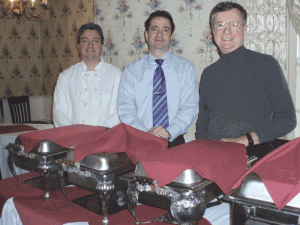
From left, Vincent Calvanese, Donald Calvanese, and their father, Andrew Calvanese, say they love the history of Storrowtown and the memories it has created for patrons.
“First, there was the challenge of revitalizing an incredible establishment. Second, it was a great opportunity for my two sons. And third, there are the memories at the Tavern, not only that I have, but that many other people had,” he told BusinessWest. “I love this place because of the personal feelings I have attached to it. And I love people, and I wanted to bring it back for them.”
The historic tavern that is a vital part of Storrowton Village was closed for two years before the Calvanese family reopened the doors, serving New England foods that have been enjoyed there for more than a century.
“Today, there is life here again, and I am very proud of what we have accomplished; this establishment is more than 200 years old, and it’s open once more. The restaurant business is hard work and takes a lot of dedication, but I was made for this,” said Andrew, who began his restaurant career 47 years ago when he was hired as a weekend cleaning person making $1 per hour at Friendly’s Ice Cream in Springfield.
The Calvanese family is happy to be in the restaurant business together and run Storrowton as a true family operation. Andrew handles public relations, while Donald is the general manager, Vincent is the executive chef, and his son Vincent is a cook.
They all love the business and believe they couldn’t find a better place to be. Before coming to West Springfield, Donald ran the food service at Wilbraham Country Club with his late mother, Doreen Calvanese, and Andrew and Vincent were at the helm of Suffield Country Club’s restaurant and pub.
However, the sons wanted to work together at a place that would allow them to grow. Donald said they looked at many restaurants before reading in a newspaper that the Eastern States Exposition sales department was looking for someone to reopen Storrowton. But nothing had seemed right — until they set foot on the old tavern grounds.
“I fell in love with it the first time I saw it,” Donald said, adding he had never eaten there. “The location is great, the building is great, and its history is interesting. The floors are uneven, and it’s impossible to heat and cool, but it has a lot of character, and we work with it.”
Andrew said the people at the Big E liked the concept of having a family run it, and the decision was made. He is proud that they were chosen out of a field of more than 40 applicants, and calls their relationship with the Big E “incredible … we are like a big family with them.”
Donald agreed and said exposition staff members played a role in helping them get the restaurant back on its feet. “It’s so nice to have a restaurant like this open again, especially with all of the chains going up. There is a lot of competition, but things are going well.”
Wayne McCary, president and CEO of the Eastern States Exposition, says the Calvanese family fit the bill.
“Storrowton Tavern is a unique part of the culture of Eastern States Exposition and its year-round events, and it was critical to create a business relationship with partners who would operate the Tavern in conjunction with the Exposition itself as well as the many shows on our grounds,” he said. “The Calvanese family is a great choice and represent the tradition of Storrowton Tavern well.”
Course of Action
However, it took a tremendous amount of work to ready the historic buildings for use again. But the family worked as a team and began renovating and cleaning even before negotiations were finished. They got down on their hands and knees and scrubbed floors, painted rooms and ceilings, put in new carpeting, and renovated the entire kitchen.
In November 2003, after months of hard work, they opened the doors Thanksgiving week and were thrilled to have 600 people enjoy the holiday there.
This year, they will feed more than 1,000 at both a sit-down meal inside the old building and at a buffet in the Carriage House across the green.
Andrew says people love the ambience of the old tavern, and they treat it and the people who come there like family. He filled a large bookcase near the doorway with part of his late wife’s collection of more than 1,000 cookbooks for people to peruse while waiting for a table, and recently finished restaining the paneled walls, which took months of painstaking labor. He and his second wife got married there, and Storrowton is his favorite place because of the “romance here,” he said.
The old tavern has a fascinating history, as it is actually two buildings that were joined together. One is Atkinson Tavern, which was built around 1789 at Atkinson Hollow in the town of Prescott. The original owner was John Atkinson, Prescott’s last surviving Revolutionary War veteran, who used it as a store, tavern, and home for his family.
Andrew likes to point out that the Vermont Room, located on the second floor above the pub and tavern, was once used as lodging for guests who stayed there.
In 1928, when the state took Prescott by eminent domain along with three other towns in the Swift River Valley to create the Quabbin Reservoir, Helen Storrow had the building moved to the Early American village she was creating in West Springfield. In 1930, the Baptist meeting house, believed to be built around 1822, was brought to Storrowton Village from Southwick. It was joined to the tavern in 1957, doubling the size and scope of the restaurant.
The tavern has five dining rooms, which are furnished with period antiques. Andrew said his family members brought many of their own heirlooms there, which include a set of Gone with the Wind commemorative plates and a glass case filled with Hummel figurines.
The Calvaneses also took over the operation of the Carriage House, a modern banquet facility which sits on the other side of the green across from the tavern. It accomodates parties of up to 350 people.
Donald loves the atmosphere and the fact that the tavern is part of the village. “You can leave the restaurant with a glass of wine and walk around the green or sit on a park bench. It looks like something out of the Colonial days,” he said, adding that they like seeing patrons enjoying the grounds.
Vincent also loves the diversity of events held on the Exposition grounds, which add to their business. “What I love about Storrowton is that there is always action here. We can have a post-funeral reception in the afternoon and a wedding at night. Plus, there are events such as the horse shows and the Big E,” he said.
Just Desserts
Andrew’s career in the restaurant business began as a cleaning person at Friendly’s. A month later, he was promoted to dishwasher, and, a month after that, he became the evening shift manager. “Within three months, I was the highest-paid part-time employee at the store, making $2.50 an hour; the food business just fit me,” he said.
After that, he spent 20 years as delicatessan manager at Gus & Paul’s Bakery and Deli in Springfield, where he discovered not only how much he enjoyed working with people, but how fulfilling it was to help them create memorable life events. His next move was to Suffield Country Club, where he stayed until moving to Storrowton.
His passion for the business was passed on to Donald and Vincent, who both worked as dishwashers at the Mountain Laurel Restaurant in Enfield, Conn. when they were young teens. Donald went on to become a waiter at area restaurants, then moved on to Mount Holyoke College, where he worked as chef/manager of its food-service operation for four years, before spending four years at Wilbraham Country Club.
Vincent was introduced to the business at age 12, when he helped out at a wedding his parents were catering. “I remember how happy we made people,” he said, adding that knowing he plays a role in people’s memorable life events continues to be rewarding, even though he is behind the scenes. During the course of his career, he worked at several area restaurants and opened one in Haydenville named DaVinci’s, which he operated for two years.
At one point, he was offered the position of head chef at Storrowton Tavern, but didn’t take it because he didn’t want to leave his family members.
Family is extremely important to the Calvanese men and women, and so is history.
“I feel like this is my second home because, when I came in here, I thought about my personal memories. And now, we are creating them for others,” Andrew said. “When we hold a party here, it’s like having a party in our own home. This is a landmark that we have revitalized, and so many people are happy this is open again.”
Vincent agreed. “We have something special here. We are working owners and always have been. We are here just to make people happy. It’s our goal, and what we want to continue to do. When I was first offered a job here, I didn’t want to leave my family. But I somehow felt like I belonged here, and here I am now. Operating Storrowton is a challenge, but one that is interesting, due to the many events staged on the Exposition grounds.”
Andrew says many people think Storrowton Tavern is open only during the Big E, and some come back every year at that time, making their own history. But memories have always been made within the tavern’s walls, and that tradition will continue, which suits him just fine.
Sturbridge Landmark Has Location and Charm — in Abundance
Back when things got started, in 1771, the Publick House was a stagecoach stop, a place to eat and sleep on the way to somewhere else. In recent times, though, this landmark has become a true destination, one known for its classic, charm, holiday decorations, traditional New England cuisine, and even a purported ghost sighting or two.It’s called the Library.
This is one of the smaller dining rooms at the Publick House in Sturbridge. It was given that name because there are old books lining the walls — well, sort of.
Because this room is rather small and space was needed to comfortably sit people and serve them, the books, perhaps 100 or more of them, were sawed in half decades ago (no one really knows when), placed within shallow bookcases, and glued to the walls. Visitors who don’t know this have tried to pull books out, sometimes tearing the binding in the process.
“We’ve thought about getting some new volumes, but the ones with the binding coming off … they add a little old charm to the room,” said Michael Glick, general manager of this landmark, parts of which date back to 1771.
Charm can be found in many places here, and in many forms. This includes some of the other dining facilities, such as the Card Room — which dates back to when the Publick House was a stagecoach stop; women were not allowed in this room then, and had to gather outside in the ‘women’s sitting room,’ which still exists today, although men sit there, too — and the Pumpkin Room, so named because of the wood used within.
But it also includes traditions, such as the scarecrow-decorating contest recently staged, the ‘breakfast with Santa’ event upcoming, and the smiley-face cookies given to each child upon completion of their meal. There’s also the menu, dominated by old New England favorites, such as pot roast, chicken pot pie, and especially turkey and sweet rolls.
And then, there are the ghost stories. “No one here now has actually seen one,” said Glick, “but there are stories … people say we have ghosts here, and we’ve had a few mediums in here to look around.”
Take all this charm and put it at what would have to be called the crossroads of Southern New England — Sturbridge sits at the intersection of I-84, the Mass. Turnpike, and Route 20 — and it would certainly seem like a recipe for business success. And some of the numbers Glick has would certainly certainly confirm this.
He estimates that roughly 1,500 people will be served dinner this Thanksgiving, the busiest day of the year for the Publick House. Meanwhile, the facility will probably handle 135 weddings this calendar year, including 11 in December, a popular month for such ceremonies at this institution because of its elaborate holiday decorations. Meanwhile, the landmark’s bakery, which records more than $500,000 in business annually by itself, will turn out more than 300,000 of those sweet rolls each year, as well as 950 pies each Thanksgiving. As for turkey, they serve more than 60,000 pounds per annum.
Overall, more than 110,000 people will visit the Publick House complex annually, for lunch, dinner, banquets, weddings, assorted get-togethers, and, of course, Thanksgiving. Some will stay in one of 115 guest rooms, 23 at the historic inn, or 92 at a motor lodge across the 62-acre complex.
For this special look at the restaurant sector, BusinessWest visits the Publick House and details why it has become a destination for people from across New England and beyond.
At a Crossroads
As he discussed the Publick House, its history, and location, Glick used the word ‘converge’ early and often.
People do a lot of that in Sturbridge, he explained, noting that, because the community is approximately in the center of Southern New England, and easy to get to from Springfield, Hartford, Worcester, Boston, New York, and just about anywhere else, families, business groups, civic organizations, and even senior-living complexes will make this the place to meet.
The ease with which people can get to the Publick House — not to mention its track record for success — is borne out in the results of a recently conducted survey of patrons.
“We asked people how far they came, and for how long they’ve been coming here,” said Glick. “The survey revealed that, on average, they’ve been coming for more than 25 years, and traveling more than 50 miles.”
Those numbers would indicate that the Publick House is truly a destination, something it wasn’t when it was founded as an inn and tavern by Col. Ebenezer Crafts in 1771. Then, as now, at least in some respects, it was a place to stop on the way to somewhere else.
Indeed, located just off the old Boston Post Road (now Route 20), the Publick House was a popular stop for those traveling or bringing commerce across the state to its capital, or from New York to Boston, something that had to be done by land during the War of 1812 because of a British blockade in the Atlantic.
Now owned by the Harrington family, which also owns the Hawthorne Inn in Salem, the Publick House complex has been expanded numerous times over the years. As he led BusinessWest on a tour, Glick pointed out a maze of hallways and staircases designed to connect buildings and additions.
Today, there are two main dining areas — the Tap Room, which can seat just over 100, and Ebenezer’s Tavern, which can host about 80. There are several other smaller rooms used for a la carte dining, however, including the Library, the Pumpkin Room, the Card Room, the Pineapple Room (so-named because the wallpaper features that fruit), and the Conference Room, among others.
There are also some larger facilities, such as the Barn Room, called that because it was an actual barn decades ago. It is often used for receptions prior to weddings and other small functions. There’s also Crafts Hall, named after the founder, obviously, which can seat 50 and is ideal for corporate meetings, and Paige Hall, named after a long-time innkeeper, and the most recent addition to the complex, in 1981. It was built over an old deck, can seat more than 200 people, and has become popular for class reunions, team functions, and other gatherings.
Talking Turkey
As he took BusinessWest through each of the rooms at the Publick House, Glick said many are not in use every night (and the restaurant is open 365 days a year), but do come into play for various types of functions or when the complex is especially busy.
But each one is full on Thanksgiving, he noted quickly. “Every nook and cranny of the place is used; there are tables everywhere — but in a comfortable fashion.”
In the Library, for example, there’s a large table that can sit 12 people comfortably. There’s also a small, alcove-like space. “People can put the kids there, just like they might at home,” he said.
Meanwhile, the bakery, which is humming most days, is especially busy on Thanksgiving and, even more so, on the Wednesday before, Glick noted. “You’ll usually find me working in the bake shop on Thanksgiving Eve,” he said, adding that many additional hands are needed to take and ring up orders, and box the pies and other desserts made for that holiday. “We sell thousands of sweet rolls for Thanksgiving.”
As for the menu, Glick said, “every day is Thanksgiving.” By that, he meant that turkey is always a popular choice, and in fact, there are two options within the ‘classics’ section of the menu — a roasted turkey dinner and a ‘Publick House Thanksgiving dinner.’ The latter comes with deep-dish apple pie or Indian pudding with ice cream, and coffee or tea.
Other ‘classics’ include baked scrod, fish and chips, chicken pot pie, shepherd’s pie, and prime rib. There is a also a ‘specialty fare’ page of the menu that includes ‘Chicken Quinn’ (topped with lobster meat, asparagus, and hollandaise sauce), barbequed salmon, peppercorn-crusted swordfish, a half rack of lamb, and Jamaican pork chop topped with pineapple salsa.
“We’re old-world New England,” Glick said, when searching for words to describe the cuisine. “Things like pot roast, chicken pot pie, lobster pie … these are New England classics; we have menus going back to the ’50s, and those items are on them — and they’ll always be there.
“What we say in our advertising,” he continued, “is that our chefs have taken those old favorites and added modern, unique twists to that menu.”
Overall, the Publick House has held up well during the prolonged downturn, said Glick, noting quickly that, like all establishments of this kind, this landmark has been impacted by the wide decline in discretionary spending, but also has benefited in some ways.
In response the global belt-tightening, the Publick House has done some discounting, which is somewhat out of character, he explained, but the specials, such as a two-for-one deal covering lunch or dinner on Mondays, Tuesdays, and Wednesdays, have certainly helped increase volume on those traditionally slower days of the week.
“Business is definitely a little slower on Thursday because of that coupon,” he explained. “But now, it’s not unusual for us to have 80 people in for dinner on a Monday, whereas before the coupon, and before the recession started, we wouldn’t approach that volume.”
The wedding business, meanwhile, has been helped by the addition of a large tent — in place between May and November — that provides couples with a different, lower-priced option. The tent has played a key role in boosting overall wedding bookings from just over 100 on average to more than 130 for 2010, and 27 ‘tent’ weddings have already been booked for 2011.
The tent, the discounting, the continuation of age-old traditions, and the addition of some new ones have definitely helped bring more people to the old inn on Route 131, said Glick, from across town, but also across the region.
The Spirit Moves Them
Glick recently received a book in the mail, an autographed copy of New England Ghosts, by David J. Pitkin. In it, on page 209 under the subheading “A Publick Ghost,” Pitkin relays the story of a couple that had an apparent encounter with a ghost while staying at the inn during the holidays in 2000.
Actually, it was the young woman who saw it while her husband was out of the room for a moment. “All at once, I had an experience I’ll never forget,” she’s quoted as saying. “To the left of the room’s doorway, another person appeared. It was an older man in a top hat and wearing what looked like an old, black, Inverness-style caped coat. He didn’t move, and didn’t seem to look directly at me. He was there for a minute surrounded by a mist or fog. He was visible for just a few minutes, and then he was no longer there.”
Glick had yet to read that account before meeting with BusinessWest, but he was aware of the story mentioned, as well as a few others. He said one of the landmark’s bartenders insisted that, through a window, he saw the ghost of Mehetable Chandler, Ebenezer Crafts’ wife, sitting at a table in the Pineapple Room (there’s a picture of her on one of the walls, so the staff would know what she looked like). And there was another incident where several guests, in different parties, said they were awoken by the sounds of glass breaking and other indications of a large-scale incident in the Tap Room. No evidence of anything was ever found.
Whether there’s any substance to these reported sightings, or encounters, is a matter of conjecture. But ghosts aside, there are plenty of other sources of charm at the Publick House — not to mention turkey and sweet rolls.
Together, it all makes this 240-year-old landmark a great place to converge.
George O’Brien can be reached at [email protected]
A Listing of Available Commercial Real Estate For Sale and Lease
Changes Are Coming to Lease-accounting Rules
The recently issued exposure draft on lease-accounting rules proves to be one of the more significant and far-reaching proposals presented this year. Even though proposed lease-accounting changes are in draft form as we write this, they have been years in the making. As a result, the core elements are unlikely to change and will impact every organization that enters into a lease agreement.
Generally speaking, the proposed lease-accounting rules will require that all assets and liabilities arising from leased assets are recorded on the balance sheet. This will effectively eliminate off-balance-sheet accounting for operating leases. The proposed requirements would affect most any organization that enters into a lease. These changes are intended to more closely align the U.S. Financial Accounting Standards Board (FASB) standards with those of the International Accounting Standards Board (IASB), acknowledging the global nature of today’s market.
Apply Right Model
The FASB’s exposure draft states that, with a few exceptions, lessees and lessors should apply a ‘right-of-use’ model in accounting for all leases. On its balance sheet, a lessee would recognize an asset representing its right to use the leased asset for the lease term and a liability to make lease payments. Meanwhile, the lessor would recognize an asset representing its right to receive lease payments depending on its exposure to risks or benefits associated with the underlying asset. Your accountant should be prepared to share additional details about this part of the proposed lease changes.
Calculating these assets and liabilities can be a challenge because the exposure draft assumes the longest possible lease term that is more likely than not to occur. To make these calculations, management, with its accounting professionals, must make certain assumptions, including expected future payments, probability of lease renewal, current and future market conditions, and other considerable changes that may affect the assets and liabilities.
A larger liability could exist in the event that lease-extension options stated in the original lease contract are exercised. For example, if the exercised lease agreement states a five-year contract, with options to extend an additional five years, and management determines it will use the space for the entire 10 years, then all 10 years of lease payments must be recorded as a liability at the present value based on all 10 years.
Key Accounting Changes
If confirmed, the proposals included in the exposure draft will result in considerable changes to the accounting requirements for both lessees and lessors.
Impacts to profit-and-loss statements as a result of the proposals in the exposure draft will be significant, as will balance-sheet alterations. Compared to current U.S. Generally Accepted Accounting Principles (GAAP) standards, if accepted, the proposals could result in much larger reductions on the profit-and-loss statements. For example, currently, U.S. GAAP requires the recognition of only a lease expense in an entity’s financial statements. The new proposal will require that same entity to recognize an interest expense on the lease liability, as well as an amortization expense on the right-of-use asset.
Here, the right-of-use asset is also subject to impairment. So an entity could record this right-of-use asset at the present value of its future minimum lease payments and immediately have to impair the asset as a result of fluctuations in the market. This could result in an extraordinary loss that would require close accounting and valuation attention as it comes into effect.
Response by Banks and Regulators
As a result of the new lease-accounting standards, balance sheets reflecting these new rules will be subject to immediate change. Will regulators and bankers consider the impact of the new lease-accounting rules when calculating financial-statement ratios and debt covenants? That’s uncertain.
We’ll have to wait and see how regulators and bankers interpret financial statements after the accounting change. To strengthen relationships with regulators and bankers, take a proactive approach by engaging in conversations about how the new lease-accounting rules will affect your business and financial statements.
Looking Forward
Tenants may prefer shorter-term leasing options to avoid recognizing larger lease liabilities. The downside is that shorter leases may increase lease rates to recover leasehold improvement build-outs and/or commissions paid to originate the lease. Some tenants may even be enticed to purchase real estate because there will no longer be a benefit to excluding these assets and liabilities from their financial statements.
The proposed lease-accounting changes will have a profound impact on all those entities that enter into leases — especially in the real-estate industry. Attending to your business yet ignoring the impending changes would be a mistake. Instead, in anticipation of the adoption of the new lease-accounting rules, talk with your accountant and build a plan to ensure the financial position of your company.
Kyle Richard, CPA, and Joe Milardo, CPA, are members of the Real Estate Services Group at Kostin, Ruffkess & Co., LLC, a certified public-accounting and business-advisory firm with offices in Springfield, as well as Farmington and New London, Conn. Beyond traditional accounting, auditing, and tax consulting, the firm also specializes in employee-benefit-plan audits, litigation support, business valuation, succession planning, business consulting, forensic accounting, wealth management, estate planning, fraud prevention, and information-technology assurance; (413) 233-2300; www.kostin.com
Chart of area Insurance Agencies
Ranked by Number of Agents
Chart of Commercial Printers
Ranked by Number of Employees
Guy Gaulin Keeps a Proud Tradition Alive at Hitchcock Press
Guy Gaulin started his career in printing as a letterpress assistant more than 60 years ago. He never lost his passion for that craft — even when most of the industry left it behind.“In the ’50s, offset printing and computerized typesetting came along, and that had some advantages over letterpress. It costs less, and you can do more with offset in the way of color process,” Gaulin told BusinessWest. “So letterpress became practically obsolete.”
But not at Holyoke-based Hitchcock Press, which was well-known for letterpress printing from its earliest days as the Wisly Company in the late 19th century, and still touts itself as a leading purveyor of the craft in the Pioneer Valley.
“This is what I’ve always wanted to do,” Gaulin said. “I liked letterpress, and it does have its place. It was my background, and I was good at it. Because offset was a lot less expensive, letterpress just got rolled over, but you did have some folks who stuck to letterpress, basically for things like limited-edition books and cards. The people doing letterpress were mainly one- and two-man shops. But for them, it was a passion. I put myself in that group.”
But he has grown Hitchcock Press to much more than that since purchasing it in 1971. The shop employs about 15 people, and commercial offset work remains the major revenue generator, allowing Gaulin to cultivate his letterpress passion for a smaller — but growing — number of clients who appreciate the artistry of the method, whether it’s for wedding invitations, business cards, letterhead, or any number of other uses.
“Commercial offset is really the core of our business, but the focus of the business is letterpress,” said Deanna Gaulin, Guy’s daughter and the shop’s vice president. “What I like about letterpress is that it’s something we can offer that other area printers do not. It’s definitely the fastest-growing area of our business, too.”
Despite its expense compared to offset printing, “our volume is increasing on letterpress,” Guy said, “which is the part I enjoy most.”
Coming Home
Gaulin was born in Holyoke to Canadian parents; when the Great Depression deepened in the 1930s, they returned to Quebec. While attending school there, he discovered a passion and aptitude for art which would continue throughout his life.
In 1944, he returned to Holyoke and joined the U.S. Navy shortly thereafter. Following the service, he began his graphic-arts career at American Pad and Paper Co., completing his letterpress apprenticeship and working as a pressman for several years before being promoted to head of AMPAD’s printing operation.
He introduced offset printing to the company, but his heart remained in letterpress.
“Offset printing took over at that time, and I did bring in offset at AMPAD,” he noted. Wisly, which changed hands in 1956 and underwent a name change to Hitchcock Press, was seeing similar changes. “But when I bought Hitchcock in 1971, it had both letterpress and offset, and we converted more and more into letterpress.”
Letterpress, which uses a reversed, raised surface to press relief text and art onto the paper, has a distinguished history; in fact, its creation in Germany by Johannes Gutenberg around 1440 is considered by many to be the most important invention of the past millennium.
His method of printing from movable type allowed, for the first time, the mass production of books; Gutenberg produced an estimated 180 copies of his most famous work, the Gutenberg Bible, in about a year, the same time it would have taken a scribe to complete one copy by hand. Fifty years after the invention of letterpress, more than 15 million books in about 30,000 titles existed in the world — changing the course of human history.
Over the next 500 years, letterpress printing continued to improve and gradually became more mechanized. But what originally made the process so revolutionary — its speed and efficiency — was a factor in its decline starting in the mid-20th century, as offset printing proved to be even faster and less expensive; it still dominates the industry today.
But the public didn’t abandon letterpress completely, and recent years has seen a resurgence in its popularity, Gaulin said.
“It came back because it has what no other printing has: depth,” he noted. “By comparison, you might say offset printing is completely flat, whereas letterpress has a different feel; it has depth, what we call an impression.”
The artistry and aesthetic pleasure of letterpress products are their major appeal to Gaulin, who has always considered himself an artist and photographer at heart but a printer by trade. Several years ago, he created a line of letterpress notecards created from his own artwork, earning an Award of Recognition at the 2005 Premier Print Awards, the world’s largest competition of printed products.
Many clients who approach Hitchcock for invitations, cards, and other projects submit designs through its Web site.
“We receive computer files, and we have plates made; we use magnesium plates because I consider them superior,” Gaulin said. Type is set manually, and artwork is placed directly onto the plate by an engraver. “When the plate is made, we run it on the letterpress.”
For wedding invitations, Deanna said, “we’ll give the bride the plate if they want it; sometimes they’ll frame it.”
Clients may design their own products or hire someone else to do it, she added, but if not, Hitchcock also offers design services. “We will help anyone who needs help to make it unique.”
And some of the shop’s recent products are striking indeed, with invitation cards ranging from a wedding reception at the Holyoke Merry-Go-Round (complete with die-cut horses) to a wedding on Oct. 30, with intricate Halloween-themed artwork rising subtly from the paper along with the text. Guy also showed off a card featuring both letterpressed text and offset artwork — a way for a client to save money.
Sharing a Passion
Gaulin has been an innovator as well. For example, he developed what he calls the GrayTone method of letterpress printing for a series of note cards and prints. Unlike halftone printing, which uses black ink only, requires one plate, and goes through the press one time, GrayTone uses gray inks and black ink, and the art is computer-manipulated to yield a certain number of gray values, each given its own plate, along with one black plate.
To demonstrate, he showed BusinessWest a calendar he produced, featuring a photo he took in the Grenadines, that was converted to five sets of plates and went through the letterpress five times to achieve a depth and richness halftone doesn’t offer.
Gaulin shares his passion for letterpress in other ways, including a blog he publishes at www.hitchcockpress.com, where he posts descriptions of various customers’ jobs, along with step-by-step photos.
It is there where he explains why he has continued working into his 80s.
“To my friends who wonder why I do not retire,” he writes in one entry, “I met a charming young lady and made her happy by designing and producing a fine letterpress wedding invitation package for her … and we became friends. What a wonderful world.”
After more than six decades in the business, Guy Gaulin is still making impressions for customers — and they’re still making an impression on him. n
Joseph Bednar can be reached
at [email protected]
A chart of area accounting firms
Ranked by Number of CPAs in Western Mass.
Take Advantage of the Repeal of the Generation-skipping Tax
Dec. 31, 2010 may be the last time, ever, to make large gifts to grandchildren without having the gifts carry a 55% tax burden.No, this is not about grandparents giving birthday, holiday, or other small gifts, because gifts with a combined value of $13,000 annually generally carry no tax, even when made to grandchildren. The $13,000 exception (called the annual exclusion) makes a gift of the latest gaming device or even a car to a grandchild free from tax, unless the gaming device comes wrapped in a house or the car is a Telsa Roadster.
Before this year, big gifts or, more often, an interest in a trust that holds an appreciating asset (an interest in a business venture or the family lake house) carried the full 55% tax burden when received by a grandchild. However, the tax could be zero if the gift is made before the end of this year.
This year only, a high-value asset may be given to a grandchild or placed in a trust for grandchildren and later generations, and avoid the 55% generation-skipping tax (GST), regardless of when the asset is distributed.
Since it was enacted in 1986, the GST has been due whenever valuable assets are distributed to persons at least two generations younger than the person who made the transfer initially. But not this year. The GST is repealed, and the impact of repeal can be huge. For example, assume Grandpa funds a trust with $1 million of GrowthCo stock on Dec. 15, 2010, the trust stays in place for 20 years, and assume that in the next 20 years the GrowthCo stock increases in value to $10 million. In year 20, when the GrowthCo stock is distributed to grandchildren, the distribution may be subject to some other taxes, but no GST will be due.
If Grandpa waits until Jan. 1, 2011 to establish the same trust with the same $1 million of GrowthCo stock, when the stock is distributed in 20 years it will be subject to a 55% GST, $5.5 million in tax. The $1 million of GrowthCo stock staying in the same trust for the same 20 years, appreciated to the same $10 million of value, will yield only $4.5 million to the grandchildren, and the federal government will get the $5.5 million difference.
The same gift made before the end of 2010 would yield the full $10 million. The only difference between the two is the application of the GST to the trust established on or after Jan. 1, 2011.
The GST is a tax that sits on top of the better-known federal estate- and gift-tax structures. The estate and gift taxes are essentially taxes on the privilege of distributing accumulated wealth. Wealth distributed during life is a taxable gift unless there is an exemption. Wealth distributed at death is subject to the estate tax, again after exemptions. The rates for the estate and gift taxes are essentially the same. The GST rate is the maximum estate-tax rate applicable when the tax is due: 45% last year, zero this year, and back to 55% next year.
Most of the popular press has focused on the temporary repeal of the estate tax in the year 2010. George Steinbrenner has been called a master tax planner for having avoided the estate tax. Unfortunately, this level of planning requires that one die in 2010. The press does not often say that the gift tax remains in effect in the year 2010. Nor do they mention the $1 million lifetime exemption from the gift tax.
At its simplest, the generation-skipping tax can be understood as a tax levied on the privilege of passing assets that skip over an entire generation. It can be illustrated by a couple of examples from 2009, before the temporary repeal. If Grandpa gave his granddaughter the $2.5 million lake house in 2009, he made what the tax law calls a ‘direct skip.’ Up until the end of 2009, Grandpa’s gift would have been subject to the gift tax when made (or would use up some of his $1 million exemption), and it would also be a subject to the GST, which was at 45% in 2009. If instead, again in 2009, Grandpa put the lake house in trust for the grandchildren, the gift to the trust would have been subject to the gift tax when the gift was made, but also subject to the GST, not at funding in 2009, but when the lake house is distributed to the grandchildren out of the trust (what your tax advisors would call a taxable termination or distribution), and using the value of the asset at distribution.
If the lake house was valued at $2.5 million in 2009 on the date of the gift, the gift tax would be paid or the exemption used at that time. The trust might provide that the house would be held for grandchildren for 20 years. If the house appreciates to $10 million in those 20 years, then on distribution to grandchildren (the taxable termination or distribution), the GST will apply at the maximum estate tax rate. At next year’s rate of 55%, the $10 million distribution would carry with it a GST liability of $5.5 million.
Like the estate tax, the generation-skipping tax is repealed for the year 2010 only. The law simply says that the GST “shall not apply to generation-skipping transfers after Dec. 31, 2009.” This opens a door for a few more weeks that has been closed since 1986.
The GST repeal effectively permits large amounts of value to be placed in trust for later generations without the later application of the GST. For the first nine months of 2010, most tax practitioners believed that Congress would act to close this substantial loophole and re-impose the GST effective as of Jan. 1, 2010. Now, as the year winds down, it appears increasingly less likely that Congress will act at all, and even if it was to act, constitutional challenges might prevent a reinstitution of the GST effective Jan. 1, 2010.
Nonetheless, making a generation-skipping trust gift on the belief that Congress won’t create a retroactive application of this tax requires some nerve, but unlike George Steinbrenner, you don’t have to die to try it. This is a door open only until Dec. 31, 2010, and it is unlikely that Congress will ever leave it open again.
Timothy P. Mulhern, Esq. is a partner at Springfield-based Shatz, Schwartz and Fentin, P.C., providing tax and business legal services since 1979; (413) 737-1131; [email protected]
New Tax Provisions Could Benefit Small-business Owners
As tax practitioners, we are often asked by our clients during tax time to help them lessen their overall tax burden. So we employ various tax strategies that apply to them and calculate their taxes. We remind our clients that we should talk often during the year so that we can better assist them with their needs.Our job is to keep up with the ever-changing tax laws, and we can do better tax planning during the year, not after. Almost comically, I tell my clients to “contact your legislator.” Call, write, e-mail, text, blog, Facebook, or Twitter them. Our elected officials are always working on tax legislation at some point during the year, and their votes will have a direct impact on what you pay for taxes.
Both of these recommendations are important, and here is why. As for contacting your legislator, to quote John F. Kennedy, “my fellow Americans, ask not what your country can do for you; ask what you can you do for your country.”
How does this apply to an article on taxation? The answer is simple: service via involvement. In the speech from which the above quote originates, he was encouraging all citizens of our country to become involved.
The economy of our country relies on the success of small business. The Small Business Administration (SBA), in its 2009 report to the president states that “half of all Americans that work in the private sector are employed in a small firm.” There are millions of small firms in America. By getting and staying involved, small businesses can and will have an impact on how they are taxed. When the small business can reduce both its own taxes and its owner’s taxes, it theoretically would have more resources available to grow the business and, ultimately, enhance the overall economy.
In 2010, there were various lobbying efforts led by businesses and business associations (or their lobbying groups). Because of this, many new tax laws were passed this year to help businesses.
However, there is a lot more tax relief needed for individuals. For example, there’s the alternative minimum tax (AMT), which, according to the non-partisan Congressional Budget Office, could affect approximately 28 million taxpayers in 2010 unless Congress acts before the end of the year. The AMT is a second tax calculation that impacts higher-income taxpayers who itemize their deductions on Schedule A.
And let’s not forget about the Bush tax cuts from 2001 that will expire on Dec. 31, 2010, which will affect every business and individual. The 10% personal income tax bracket will go away, the marriage penalty will come back, and capital gains tax rates will increase. Congress, by not acting on this, will raise everyone’s taxes on Jan. 1, 2011. Ouch.
Recently Enacted Tax Changes
The remainder of this article focuses on the recent Small Business Jobs Act of 2010, which was signed into law by President Obama on Sept. 27. These are the highlights of this legislation:
• SBA loan limit increase. It’s no secret that, during a recession, credit for businesses is hard to obtain, if not impossible. With revenues down, many small businesses are becoming undercapitalized, and may also have a lot of cash tied up in receivables or inventories. An option available for credit has always been by way of a Small Business Administration loan, or SBA loan for short, obtainable through most banking institutions.
These loans have federal government backing that makes a favorable credit decision by your bank a lot easier to obtain. In this new legislation, the maximum lending limit for SBA loans was permanently increased to $5 million for two of its largest loan programs, the 504 and 7(a) loan. A manufacturer could qualify for up to $5.5 million in the 504 program. It also temporarily increases the more popular SBA express loans from a maximum of $350,000 to $1 million. Smaller businesses often utilize these fast-track loans with fast approval and lower fees.
• Increase in Section 179 capital acquisitions. This provision gives a company the option to expense up to $500,000 of eligible new capital equipment and furnishings purchased, if the total capital outlays are less than $2 million. This section of the federal tax code, more commonly referred to as the Section 179 deduction, was set to return to a maximum of $25,000 to write off in 2011. Congress, in expanding the total capital purchases limit to $2 million, significantly expands this favorable tax deduction to up to $4.5 million for individuals and businesses to get this benefit, according to the president’s press release on Sept. 27, when he signed this legislation into law.
• New $30 billion lending fund. This new fund was established to provide smaller banks with much-needed capital and incentives to then lend out to small businesses. According to the legislation, eligible institutions “must provide to the government a small-business-lending plan describing how the institution’s business strategy and operating goals will allow it to address the needs of small businesses in the areas it serves, as well as a plan to provide linguistically and culturally appropriate outreach, where appropriate.”
• Health-insurance deduction for the self-employed. This provision now allows a self- employed business owner to deduct the cost of their own health insurance premiums on their Schedule C profit or loss from business. These business owners were previously allowed to take this as a deduction from their adjusted gross income and reduce their taxable income only. The new provision allows for the health-insurance deduction against the self-employment tax, which could amount to a 14.13% tax savings on the premiums paid.
• $10,000 deduction for start-up costs. This provision allows for a new company to expense its startup costs of up to $10,000, if no more than $60,000 is spent. Startup costs, which typically include initial fees for attorneys, consultants, state filing fees, and other one-time setup costs, are normally capitalized and amortized over a number of years. A new company may elect to opt out of the expensing option, especially if it already has a loss for the first year.
Meet with Your Outside Accountant
Chances are you have one. If you don’t, consider getting one. The reason you’re in business is because you have a niche and do it well enough to have your own business. The reason you need an outside accountant is because they too have a niche and do it well enough to help you and your business. In other words, do what you do on a daily basis because it is what put you where you are in the first place, and use the expertise of an independent accountant or CPA to advise you on tax strategies.
Your CPA should be acutely aware of your business and keep you abreast of any new or changing tax initiatives that apply to you and your business. Your CPA should also know your banker and be able to work directly with you and them in designing lending programs that fit. Remain in contact with your CPA frequently during the year, even if it’s a quick phone call or e-mail. Even more importantly, schedule a review of your year-to-date financials well before Dec. 31 so that you will have ample time to implement their suggestions into your own personal scenarios.
Conclusion
One key to success for you and your business is to stay in contact with your accountant. He or she can be an important and reliable asset to you and your business, whether it’s by helping you with financing, business advice, or tax planning. And stay on those legislators; they may even help you with tax relief if enough businesses and individuals get involved.
Nicholas LaPier, CPA, is the principal at Nicholas LaPier CPA, P.C., located in West Springfield; (413) 732-0200; www.lapiercpa.com
A list of area physical therapy and rehab services
Medical Society Study Shows Continued Primary Care Shortages
The Mass. Medical Society recently released its annual Physician Workforce Study, showing a fifth consecutive year of shortages of primary care physicians, half of primary care practices closed to new patients, shortages in 10 of 18 physician specialties across the state, and community hospitals continuing to be the most affected by persistent physician shortages.
The 2010 study is the society’s ninth annual look at multiple aspects of the physician workforce, and builds on the previous eight years of data. The study surveys teaching hospitals, community hospitals, practicing physicians, medical directors of medical groups, and resident and fellow programs throughout the state. It is the most comprehensive examination of the physician workforce in the state done on an annual basis.
The report’s key findings include:
• The primary care specialties of family medicine and internal medicine are in critically short supply, the fifth consecutive year of shortages for these specialties;
• Ten of 18 specialties studied have been found in short supply, three more than last year;
• High percentages of primary care practices are closed to new patients: 54% of family medicine physicians and 49% of internal medicine physicians are not accepting new patients;
• Wait times for new patients for primary care continue to be long, with an average wait time of 29 days for family physicians and 53 days for internists;
• With the exception of Boston, physician shortages exist in all regional labor markets across the state;
• Community hospitals continue to be the most seriously affected by the physician shortages, with difficulty filling vacancies and retaining physicians, resulting in the need to alter services and change staffing patterns; and
• The fear of being sued remains a substantial negative influence on the practice of medicine, affecting access to and availability of physician services.
“The findings from this latest analysis,” said Dr. Alice Coombs, president of the Mass. Medical Society, “clearly show how fragile access to care for patients is across the entire Commonwealth.
“The state’s universal health care plan has improved access to care,” she continued, “but universal coverage and access can only be sustained with a strong physician workforce. As we continue to look at reforming the health care system, we must do so carefully and deliberately in all aspects, and that includes the next steps for cost control, particularly with respect to establishing a fair system of payment reform.
“A strong physician workforce is critical to delivering top-quality and cost-effective care,” Coombs went on. “If physicians think that the viability of their practices is threatened or unsustainable under a new payment system, Massachusetts may encounter further problems with recruitment and retention. And that, certainly, will affect patient care.”
Coombs said the physician workforce in Massachusetts continues to be affected by a lingering poor practice environment in the state. The Society’s Physician Practice Environment Index, a statistical indicator of nine factors that shape the environment in which physicians provide patient care, dropped 0.8% in 2009, and has fallen in 16 of the past 18 years. Since 1992, the Massachusetts Index has declined by 26.4%, significantly more than the 21.3% decline in the comparable national index. The index takes into account such factors as the cost of maintaining a practice, median physician income, liability insurance rates, and hours spent on patient care.
Here are some details on the report’s key findings:
Specialties Classified in Short Supply
The medical society’s 2010 analysis found 10 of 18 specialties studied in short supply: dermatology, emergency medicine, family medicine, general surgery, internal medicine, neurology, orthopedics, psychiatry, urology, and vascular surgery.
Over the last three years (2008-10), six specialties have been operating within tight labor market conditions in each of those years: family medicine, internal medicine, vascular surgery, urology, dermatology, and neurology.
A trend analysis over a five-year period (2006-10) shows that 11 specialties have been in short supply in at least three of those five years: family medicine, internal medicine, vascular surgery, urology, dermatology, neurology, psychiatry, general surgery, orthopedics, emergency medicine, and neurosurgery.
Primary Care Practices Closed to New Patients; Long Waits
The primary care specialties of internal medicine and family medicine continue to be under intense pressure following the establishment in 2006 of the state’s health care reform law, which resulted in some 440,000 residents being added to the insurance rolls.
A survey of physician practices showed that approximately half of primary care physicians are not accepting new patients. The percentage of family medicine physicians who are not accepting new patients has increased from 30% in 2007 to 54% in 2010 — the highest it has been in four years. The percentage of internal medicine physicians no longer accepting new patients decreased slightly from the previous year to 49% in 2010 — the same level it was in 2007.
Meanwhile, long wait times for appointments for new patients continue. For internal medicine, the average wait time increased to 53 days, nine days longer than last year’s figure of 44 days and the highest it has been in six years. For family medicine, the average wait time is 29 days, 15 days shorter than last year’s figure of 44 days.
Shortages Across the State
A regional analysis of the 18 specialties for the five metropolitan statistical areas in the state (Boston, Worcester, Springfield, New Bedford/Barnstable, and Pittsfield/Western Mass.) found that, with the exception of Boston, all regional labor markets were experiencing shortages of physicians. Critical shortages exist in Pittsfield/Western Mass. and Worcester.
In an analysis of the 18 specialties examined by the study, the percentage of practicing physicians in the four labor markets of New Bedford/Barnstable, Pittsfield/Western Mass., Springfield, and Worcester who responded that they were dealing with an inadequate pool of physicians, had difficulty in filling vacancies, needed to alter services, and needed to adjust staffing exceeded the percentage of physicians in the Boston market by at least nine percentage points.
In the four labor markets outside of Boston, more than two-thirds of the practicing physicians said there was an inadequate pool of physicians for recruiting. This characteristic was especially acute in New Bedford/Barnstable and Pittsfield/ Western Mass., where more than eight out of 10 said the pool was inadequate.
Community Hospitals Are Most Affected By Shortages
Community hospitals continue to be the most affected by the consequences of physician shortages. All (100%) of the medical-staff presidents of community hospitals reported they are experiencing difficulty filling vacancies, and 82% reported that the amount of time to recruit a physician has risen, an increase of 5% over the average of the previous eight years of the studies.
Community hospitals are also reporting the most difficulty with retaining physicians, with 64% saying retention has become harder over the past three years. However, this is an improvement from the average of the previous seven-year period, when 79% reported difficulty in retaining physicians.
Additionally, 64% of community hospitals reported that physician shortages required them to alter the services they provide, a substantial increase from 43% in last year’s study. Meanwhile, 82% of medical-staff presidents responded that physician-supply problems required adjustments in their staffing patterns, a large increase from 64% last year and the average ratio of 56% for the years 2003-09.
Professional Liability Hinders Practice of Medicine
The 2010 study once again found that medical malpractice concerns and the fear of being sued continue to have a substantial negative influence on physicians and the practice of medicine. This finding is consistent with the society’s previous workforce studies and its first-of-a-kind Investigation of Defensive Medicine in Massachusetts, released in November 2008, which showed that the fear of being sued is a serious burden on health care. Findings from the 2010 Workforce Study:
• A full 46% of practicing physicians surveyed said their practice has been altered or limited because of the fear of being sued, the same percentage as last year; and
• More than half of physicians in five specialties said they have altered or limited their practice because of the fear of being sued: neurosurgery (82%); urology (74%); emergency medicine (70%); orthopedics (70%); and obstetrics/gynecology (60%). Also, 40% or more of physicians in nine other specialties have changed their practice for the same reason: cardiology, neurology, gastroenterology, general surgery, dermatology, psychiatry, radiology, internal medicine, and family medicine.
Additional Findings
For the first time, more physicians (43%) expressed satisfaction with the practice environment than not (41%).
However, more physicians expressed displeasure with the tradeoff between patient care and administrative tasks. More than half (51%, up from 44% last year) of all practicing physicians regardless of specialty expressed displeasure with the abundance of administrative measures. Among primary care physicians, 59% expressed displeasure.
A chart of banks in Western Mass
Ranked by Total Assets* (Dollars in Thousands)
Management Must Set the Tone When It Comes to Preventing Fraud
It is good business practice to periodically review and revise control activities. Internal control is the process designed to ensure reliable financial reporting, effective and efficient operations, and compliance with applicable laws and regulations. Safeguarding assets against theft and unauthorized use, acquisition, or disposal is also part of internal control.Monitoring your company’s assets can improve year-end bonuses to deserving employees and the owners. It safeguards funds to invest in company equipment or pay down debt, and ensures the accuracy of financial reporting to the bank.
Ultimately, the responsibility for internal control rests with the management and owners of an organization; monitoring the controls can be an ongoing exercise as staffing levels fluctuate and responsibilities change. If controls are not monitored, you risk using line-of-credit funds to offset misallocated cash or replace stolen inventory.
The news has brought us many stories of fraud over the past few years. There are three requirements for fraud — incentive or pressure, opportunity, and attitude or rationalization. Greed is not the only driving force; unfortunately, this economy brings many pressures, and an individual faced with a desperate situation can consider actions very unlike their character.
To reduce the risk of fraud, you need to break the triangle. Create an ethical environment, reduce opportunities, and monitor pressures on employees (without invading their privacy). Be alert if a staff person is experiencing financial difficulties. Prevention and detection techniques include performance reviews (for example, comparing current financial reports to other information, perhaps reported sales to merchandise shipments), independent checks (an employee’s work is re-performed or tested by a supervisor or the computer), and rotating employee responsibilities.
In speaking of internal controls, you’ll hear the phrase ‘tone at the top.’ Company leaders can let their employees know they value honesty and encourage whistle-blowing. Violators should be prosecuted.
In monitoring controls, consider first which assets are most vulnerable to theft or fraud. In most cases this is cash, although you could also have inventory that is easy to take and sell outside the company. As you review organizational control procedures and contemplate risk, consider implementing the following:
• An owner should avoid relying solely on one trusted individual, even if that person maintaining the ledgers is family or like family. Don’t let personal relationships blur your perspective.
• Know your company’s procedures. If they aren’t already, consider putting them in writing. Written procedures avoid misinterpretation. Start by asking each person to write down what it is they do. Review with an eye as to how and where in the process things can go wrong.
• Require employees to take one- or two-week vacations. This includes cross-training employees so that someone else does the job during the vacation.
• The business owner should receive the bank statement unopened, possibly sent to his home address. He should review the bank statement for reasonableness; note signatures on the imaged cancelled checks, the payees, and the amount; and check that transfers and other charges are appropriate.
• Once the bookkeeper has prepared the monthly bank reconciliation, the owner should review the reconciliation to question unusual reconciling items.
• Someone other than the bookkeeper should open the mail. A third office person can make a dated listing of the incoming checks that can later be compared to the related validated deposit ticket.
• Someone other than the person posting the payments to the customer ledger should inquire of customers regarding old accounts receivable. Periodically evaluate customer credit limits to their outstanding balances. Perhaps customers with old balances haven’t had their accounts suspended. Only the owner should approve customer write-offs, never the individual collecting the cash.
• Ideally the bookkeeper should never have check-signing authority or access to a signature stamp. The owner should sign all checks after reviewing attached invoices.
• Payroll registers should be reviewed for correct number of hours, proper pay rates, that withholdings are subjected and not shown as a negative (an add-back), and that all names are known employees. A separate individual could track paid time off to be sure the amount taken is in agreement with pre-approved days or hours.
• Review general journal entries for unusual items, and randomly review backup documentation. Journal entries should be approved by someone with authority over those who create and post the entry.
• All equipment should be marked for ownership.
• Inventories should be adequately safeguarded; it is often more difficult to prevent and detect inventory fraud than other asset thefts. This is due to the large quantity of items in the inventory, the number of employees with access to inventory (possibly due to complicated processes involved in production), and the many entries and possibly complex systems used to account for the inventory and production process. Inventory that is small, portable, high in value, or in high demand is more susceptible to theft.
Theft of inventory can include the following: stealing inventory and scrap for personal use or resale; scrapping good merchandise and, with collusion, selling it to customers or distributors; returned product being recorded as sales returns but never restocked and instead sold by the perpetrator; or concealing other fraud by increasing the inventory accounts, as when a perpetrator writes a check to himself and records the debit to inventory.
Preventive or detective controls for inventory include securing the perimeter of the building, separating the duties of purchasing and warehousing from approving inventory purchases and disbursements; and periodically analyzing the components of costs of sales (material, labor, and overhead) as a percentage of sales. Inventory should be periodically counted, costed, and compared to control accounts and/or perpetual records.
Business owners and managers can ask their office staff for internal control information in addition to regular monthly financials. Depending on what your business is, you could request product sales statistics, reports on inventory shrinkage, old inventory information, sales returns reports, and edit reports that compare like-items from different areas of the business.
In summary, know your company’s procedures — who, what, when, which document, and where can things go wrong. Implement cross-checks, and review procedures periodically. Are they being performed as designed, or do the procedures need to be modified to address a change in staff or business activities?
Your CPA can help if you have a question. Effective controls start and stop with management and the business owner. This doesn’t mean that you, individually, have to perform every check and balance. Set the tone, and let your employees and vendors know you adhere to good business standards. It also means making sure the controls are happening as designed, with periodic inquiries to staff and viewing their logs. Call your accountant to schedule their visit to your business to receive details on these and other steps that can help secure your business assets. This could reveal critical controls that have been overlooked. n
Donna Roundy, CPA serves as the senior audit manager in charge of the not-for-profit practice at Meyers Brothers Kalicka, P.C. in Holyoke. She is also the firm’s technical advisor on uniform financial reporting and compliance. Her primary focus is auditing and includes servicing not-for-profit and real-estate organizations with subsidized housing, as well as financial-statement preparation for closely held businesses; (413) 536-8510.
Largest Manufacturers
Ranked by the Number of Total EmployeesLargestManufacturers BW11.10a
AMICCON Event Will Spotlight Companies, New Technologies
Ellen Bemben said she wasn’t sure this past summer how many manufacturers were coming to AMICCON, but she’s no longer concerned.“If you asked us five or six weeks ago, it was going slowly, but then in September, people were getting back from vacations, and this thing pretty much took off,” said Bemben, one of the event organizers. “What a lot of manufacturers are telling us is that they finally have their own personal forum. There’s a lot of enthusiasm. This is going to be a happening.”
AMICCON, or the Advanced Manufacturing & Innovation Competition and Conference, was conceived in the fall of 2009, when area business leaders began discussing the issue of manufacturers awarding contracts outside the region, in most cases because they are not aware of the qualified supply-chain members and innovators doing business in their own backyard.
The program’s initial stage is a Nov. 16 event at the MassMutual Center in Springfield that will bring together manufacturers in several different categories to make key business connections.
“The goal is to bring business to the region and increase awareness among local manufacturers about what other manufacturers in the area are doing,” said Eric Hagopian, president of Hoppe Tool in Chicopee and an AMICCON steering committee member. “Together, we can really build on our reputation as a region for precision manufacturing of all types.”
According to event organizers, despite the richness and diversity of the region’s manufacturing sector, many manufacturers and supply-chain members are not aware of all that is produced in the Springfield-Hartford corridor.
As a result, they look outside this area — to other regions of the U.S. or even internationally — to supply goods that are actually being produced locally. When that happens, they lose potential customers — and profits.
The Nov. 16 event should start to turn that around, Bemben said.
“Manufacturers are excited. I think it’s because we’re grassroots, bootstrapping, apolitical,” she noted. “I like that they’re coming in from all areas, not just Massachusetts and Connecticut; some folks are coming in from as far away as New Jersey, New York, and New Hampshire.”
According to the AMICCON steering committee, the program’s goals include:
• Soliciting and exposing innovation in manufacturing, in areas ranging from products, processes, and IT to nanotechnology, robotics, coatings, and advanced materials, integrated systems, inventory management, and order tracking;
• Identifying local, qualified supply-chain members and introducing them to the region’s manufacturers through a dedicated Web site and database;
• Introducing original equipment manufacturers, procurement, and government contractors to the region’s advanced manufacturers through a continuum of highly focused programs;
• Promoting the region’s strengths in precision machining, plastics, paper and packaging, green technology, electronics, and medical devices; and
• Creating the region’s first manufacturing innovation competition, designed to promote the sort of forward thinking that has lent the Springfield area its manufacturing heritage.
Event organizers say that, while Western Mass. manufacturers must compete to survive, they also benefit when the entire sector is healthy, and to create that robustness, they need to show each other what they have to offer, along with attracting customers from outside the region.
Bemben said companies will have a chance to spotlight new technologies on Nov. 16 at a venue called the Innovation Station. For example, FloDesign plans to discuss a prototype for water purification using sonic technology, while Poly-Plating will show off a closed-loop system it created to recycle acidic water. Meanwhile, Universal Plastics might bring a thermoformed birthing tub, and Rensselaer Polytechnic Institute will be on hand with a variety of robotics.
“I think it’s going to be a very fast day,” Bemben said, stressing again that the event is only the first step in a long-term effort to boost manufacturing in the region. “It’s not going to be just one day, one event, where we walk away and say, ‘yippee, yay, we did something.’”
Hagopian, like Bemben, is pleased to hear that enthusiasm is rising.
“Any event like this is difficult to get off the ground in its first year,” he told BusinessWest. “But once you build up that momentum, people get excited and sign on. And when they see the value the show brings to the table for the region, they come back, and it’s a lot easier to get it done the next year. It becomes a bigger, more effective show.”
And a stronger, more robust region.
— Joseph Bednar
Hospital Interpreters Translate More Than Just Words
A law requiring interpreter services in Massachusetts hospitals is less than 10 years old, but most facilities have offered them for much longer — and for good reason. At some hospitals, tens of thousands of non-English speakers walk through the doors each year, facing not only a language hurdle, but cultural barriers as well. As local patient interpreters explain, they play a critical role in health care, one that extends beyond mere words.Tim Moriarty says some patients who don’t speak English want to bring their own interpreter — a friend or family member — into the examination room. But that’s usually not a good idea.“They tend to withhold information from the patient. They might not know some vocabulary. And they often provide opinion, and you don’t know that they’re saying, ‘your cousin Bill had this same procedure last year, and he died, so you shouldn’t have it,’” said Moriarty, manager of Interpreter and Translation Services for Baystate Health.
Better to use one of the professional interpreters that hospitals are required by law to provide patients who don’t speak English.
“One of the standards of practice is transparency, to relate what’s said without adding or omitting anything,” he told BusinessWest. “Interpreters actually speak in the first person: ‘I feel pain today.’”
And when speaking for the doctor or nurse, they address the patient in the same way, as if they were the provider.
Ramona Quintana, who coordinates interpreter services at Mercy Medical Center, said it’s all about becoming a conduit, as if the third person in the room doesn’t exist.
“As an interpreter, I am not me,” she explained. “I’m trying to be as invisible as I can become, and my words and even my gestures become that of the patient, so the provider gets an idea of what’s going on, so he knows how to treat that patient — not just medically, but also with other issues that might be present.”
Quintana said some people have the impression that interpreting in a medical setting is easy work, simply reciting back and forth. “But it’s not just repeating words; it’s interpreting meaning.”
And it’s complex work, which is why a national certification for hospital interpreters has been established, starting with Spanish speakers this year; other languages will follow.
This month, BusinessWest examines how interpreter services are implemented at area hospitals, and why such programs are so necessary. After all, at such a critical moment in someone’s life, it’s important to have someone speaking not on their behalf, but directly in their place.
Beyond the Law
While most hospitals in Western Mass. have had interpreter services available from at least the mid-’90s, if not before, such programs were not mandated by state law until 2001. The law requires hospitals to provide ‘competent,’ trained interpreters, not family members. It also requires hospitals to designate a coordinator or director of such services; to post notices in emergency rooms, psychiatric units, and registration areas advising patients of their right to an interpreter; and translate relevant documents into languages commonly encountered at the hospital.
“Patients have a right to an interpreter, and that’s posted,” Quintana said, a standard document that outlines that right in dozens of languages. Quintana said Mercy sees not just Spanish speakers, but also Russian, Polish, Portuguese, Vietnamese, and Chinese speakers, among others.
“It’s quite a diverse community we serve as we try to meet these needs. And the languages we don’t speak, we reach through agencies in the area,” she explained, adding that interpreters need to be aware of vocabulary and cultural differences even within the same language group. “There are so many different cultures that speak Spanish, and South America is different than Mexico.”
While Massachusetts is among the states that have been responsive to the need for interpretive services, others cannot make the same claim, which is why national certification is a good idea, Moriarty said.
“Right now there are no national minimum requirements for interpreters,” he noted. “Some states have instituted testing and certain requirements, but most states don’t have that. National certification will require the interpreters in the field to demonstrate their knowledge or functional understanding of their practice, their knowledge and fluency in English and a second language, and their knowledge of medical terminology in both languages.”
Those requirements, he continued, will make it much easier for managers doing the hiring, because they can make assumptions that someone has a high skill level prior to being hired and not just count on someone’s education and state certification, if any, the requirements for which can vary widely from state to state. “Now, interpreters, will have to prove their skills before we bring them on board, and that minimizes the risk, especially to the patient. It ensures that communication between the patient and provider will be very clear.”
Because of Baystate’s size and the fact that about 80,000 patient visits require language translation each year, it boasts a wider range of interpreting skills in house than other regional hospitals, Moriarty said. Its staff of 45 can interpret Spanish, Vietnamese, Polish, Arabic, and Mandarin, and it works with two local agencies to provide services in Swahili and Khmer, among others. “Then, if a really unusual language comes up, which sometimes it does, we have telephonic interpreting with a company that assists us with more than 100 languages in less than 30 seconds.”
At Holyoke Medical Center, Spanish is the overwhelming language barrier, said Rafael Mojica, coordinator of the Community Outreach Department, of which interpreter services are a part. “Last year alone, we had almost 18,000 visits from Spanish-speaking patients who didn’t speak English, but we also had about 2,400 visits from patients who didn’t speak English but spoke another language, like Polish, Portuguese, Russian, Vietnamese, or Arabic,” he explained. Other patient visits required interpretation of Cantonese, French, Tagalog, Italian, Somali, Urdu, Gujarti, and sign language.
“We have staff in person from 6:30 in the morning to 11:30 at night, and overnight we have telephonic interpreting services that speak about 150 languages,” Mojica said. And because the hospital experience can be confusing and frustrating for a non-English speaker from a different culture, Mojica’s department goes beyond making sure services are provided when patients come through the door during the day.
“We originated what we call daily rounds,” he explained. “Every single morning, we have a medical interpreter visit all the bilingual patients and new admissions, and every morning we get a report making sure they can either speak the language or are informed of our services. And we make sure that, if any provider comes in, they call the interpreter. It’s pretty simple; we carry cell phones around the hospital, and we’re a phone call away.”

Emma Dias used to be an architect, but she gets more satisfaction building bridges between patients and care providers.
“It’s very rewarding,” she said. “I was an architect for more than 10 years, and I never felt that rewarded. This is a really great field.”
Because CDH, like most all Western Mass. hospitals, also encounters more Spanish speakers than any other non-English language, Dias serves as a Spanish-speaking coordinator, and two per-diem interpreters also specialize in that language. Another per-diem interpreter speaks Portuguese (as does Dias), and the hospital contracts with an outside agency for other commonly heard languages, including Korean, Cambodian, and Chinese.
The hospital ensures that an interpreter stays with a patient who needs assistance throughout his or her visit, leaving when there’s a wait and returning for the next test or meeting with a provider.
Beyond the Language
Even without the national certification, New England hospitals have proven to be progressive when it comes to honing interpretive skills. Moriarty serves as president of FOCIS (the Forum on the Coordination of Interpreter Services), members of which meet bimonthly at different hospitals across Massachusetts. They discuss issues including interviewing interpreters, working with interpreter contract agencies, defining patient encounters, and developing a basic assessment tool. The FOCIS model has since migrated across the Northeast and even to North and South Carolina.
And what hospitals are assessing isn’t just how well an interpreter knows the language, but, as Quintana noted, how well they help patients from different backgrounds and cultures navigate an often-anxious time.
“We need to guide patients,” she told the BusinessWest. “We not only serve as interpreters, but we meet different cultural needs. When a patient comes in, we ask that patient through an interpreter if they have any cultural needs that would make their stay more comfortable.”
At Holyoke Medical Center, Mojica said, not only are the interpreters fluent in at least two languages (English and Spanish), have formal interpretive training, and understand medical terminology, but they’ve also received specialized training in the areas of substance abuse, mental health and crisis intervention, domestic violence, oncology and bereavement, cultural competence, and diversity. Recently, interpreters underwent a five-week training course on health interpretation taught with the specific needs of the hospital in mind, reflecting the sort of emphasis on continuing education seen in many Massachusetts hospitals.
“It’s a very rewarding job,” said Mercy’s Quintana. “We do and see it all. It is about quality of life, and that spreads out to the community when patients leave, and society as a whole benefits.”
Yet, while seeing and hearing plenty during patient encounters, she said interpreters are trained not only to be good listeners, but also “fast forgetters,” due to the obvious privacy issues raised by having a third person in the doctor’s office or testing room.
“We also have to read body language. Different cultures have different body language,” she said, noting that certain gestures that are friendly in one culture are disrespectful in another. “Interpreting is more than words.”
Still, she said she sees herself largely as a conductor of language, like metal conducts electricity, hopefully presenting the meaning unchanged to the doctor, and the provider’s instructions back to the patient.
Her job, and that of other medical interpreters, is like electricity in another way, too, shining a light on what might otherwise be a dark, confusing experience. n
Joseph Bednar can be reached at
[email protected]
“They tend to withhold information from the patient. They might not know some vocabulary. And they often provide opinion, and you don’t know that they’re saying, ‘your cousin Bill had this same procedure last year, and he died, so you shouldn’t have it,’” said Moriarty, manager of Interpreter and Translation Services for Baystate Health.
Better to use one of the professional interpreters that hospitals are required by law to provide patients who don’t speak English.
“One of the standards of practice is transparency, to relate what’s said without adding or omitting anything,” he told BusinessWest. “Interpreters actually speak in the first person: ‘I feel pain today.’”
And when speaking for the doctor or nurse, they address the patient in the same way, as if they were the provider.
Ramona Quintana, who coordinates interpreter services at Mercy Medical Center, said it’s all about becoming a conduit, as if the third person in the room doesn’t exist.
“As an interpreter, I am not me,” she explained. “I’m trying to be as invisible as I can become, and my words and even my gestures become that of the patient, so the provider gets an idea of what’s going on, so he knows how to treat that patient — not just medically, but also with other issues that might be present.”
Quintana said some people have the impression that interpreting in a medical setting is easy work, simply reciting back and forth. “But it’s not just repeating words; it’s interpreting meaning.”
And it’s complex work, which is why a national certification for hospital interpreters has been established, starting with Spanish speakers this year; other languages will follow.
This month, BusinessWest examines how interpreter services are implemented at area hospitals, and why such programs are so necessary. After all, at such a critical moment in someone’s life, it’s important to have someone speaking not on their behalf, but directly in their place.
Beyond the Law
While most hospitals in Western Mass. have had interpreter services available from at least the mid-’90s, if not before, such programs were not mandated by state law until 2001. The law requires hospitals to provide ‘competent,’ trained interpreters, not family members. It also requires hospitals to designate a coordinator or director of such services; to post notices in emergency rooms, psychiatric units, and registration areas advising patients of their right to an interpreter; and translate relevant documents into languages commonly encountered at the hospital.
“Patients have a right to an interpreter, and that’s posted,” Quintana said, a standard document that outlines that right in dozens of languages. Quintana said Mercy sees not just Spanish speakers, but also Russian, Polish, Portuguese, Vietnamese, and Chinese speakers, among others.
“It’s quite a diverse community we serve as we try to meet these needs. And the languages we don’t speak, we reach through agencies in the area,” she explained, adding that interpreters need to be aware of vocabulary and cultural differences even within the same language group. “There are so many different cultures that speak Spanish, and South America is different than Mexico.”
While Massachusetts is among the states that have been responsive to the need for interpretive services, others cannot make the same claim, which is why national certification is a good idea, Moriarty said.
“Right now there are no national minimum requirements for interpreters,” he noted. “Some states have instituted testing and certain requirements, but most states don’t have that. National certification will require the interpreters in the field to demonstrate their knowledge or functional understanding of their practice, their knowledge and fluency in English and a second language, and their knowledge of medical terminology in both languages.”
Those requirements, he continued, will make it much easier for managers doing the hiring, because they can make assumptions that someone has a high skill level prior to being hired and not just count on someone’s education and state certification, if any, the requirements for which can vary widely from state to state. “Now, interpreters, will have to prove their skills before we bring them on board, and that minimizes the risk, especially to the patient. It ensures that communication between the patient and provider will be very clear.”
Because of Baystate’s size and the fact that about 80,000 patient visits require language translation each year, it boasts a wider range of interpreting skills in house than other regional hospitals, Moriarty said. Its staff of 45 can interpret Spanish, Vietnamese, Polish, Arabic, and Mandarin, and it works with two local agencies to provide services in Swahili and Khmer, among others. “Then, if a really unusual language comes up, which sometimes it does, we have telephonic interpreting with a company that assists us with more than 100 languages in less than 30 seconds.”
At Holyoke Medical Center, Spanish is the overwhelming language barrier, said Rafael Mojica, coordinator of the Community Outreach Department, of which interpreter services are a part. “Last year alone, we had almost 18,000 visits from Spanish-speaking patients who didn’t speak English, but we also had about 2,400 visits from patients who didn’t speak English but spoke another language, like Polish, Portuguese, Russian, Vietnamese, or Arabic,” he explained. Other patient visits required interpretation of Cantonese, French, Tagalog, Italian, Somali, Urdu, Gujarti, and sign language.
“We have staff in person from 6:30 in the morning to 11:30 at night, and overnight we have telephonic interpreting services that speak about 150 languages,” Mojica said. And because the hospital experience can be confusing and frustrating for a non-English speaker from a different culture, Mojica’s department goes beyond making sure services are provided when patients come through the door during the day.
“We originated what we call daily rounds,” he explained. “Every single morning, we have a medical interpreter visit all the bilingual patients and new admissions, and every morning we get a report making sure they can either speak the language or are informed of our services. And we make sure that, if any provider comes in, they call the interpreter. It’s pretty simple; we carry cell phones around the hospital, and we’re a phone call away.”
Emma Dias, coordinator of Medical Interpreter Services at Cooley Dickinson Hospital, said it’s gratifying to see interpreters make a real difference in someone’s hospital experience, which is often an anxious time even without language and cultural barriers.
“It’s very rewarding,” she said. “I was an architect for more than 10 years, and I never felt that rewarded. This is a really great field.”
Because CDH, like most all Western Mass. hospitals, also encounters more Spanish speakers than any other non-English language, Dias serves as a Spanish-speaking coordinator, and two per-diem interpreters also specialize in that language. Another per-diem interpreter speaks Portuguese (as does Dias), and the hospital contracts with an outside agency for other commonly heard languages, including Korean, Cambodian, and Chinese.
The hospital ensures that an interpreter stays with a patient who needs assistance throughout his or her visit, leaving when there’s a wait and returning for the next test or meeting with a provider.
Beyond the Language
Even without the national certification, New England hospitals have proven to be progressive when it comes to honing interpretive skills. Moriarty serves as president of FOCIS (the Forum on the Coordination of Interpreter Services), members of which meet bimonthly at different hospitals across Massachusetts. They discuss issues including interviewing interpreters, working with interpreter contract agencies, defining patient encounters, and developing a basic assessment tool. The FOCIS model has since migrated across the Northeast and even to North and South Carolina.
And what hospitals are assessing isn’t just how well an interpreter knows the language, but, as Quintana noted, how well they help patients from different backgrounds and cultures navigate an often-anxious time.
“We need to guide patients,” she told the BusinessWest. “We not only serve as interpreters, but we meet different cultural needs. When a patient comes in, we ask that patient through an interpreter if they have any cultural needs that would make their stay more comfortable.”
At Holyoke Medical Center, Mojica said, not only are the interpreters fluent in at least two languages (English and Spanish), have formal interpretive training, and understand medical terminology, but they’ve also received specialized training in the areas of substance abuse, mental health and crisis intervention, domestic violence, oncology and bereavement, cultural competence, and diversity. Recently, interpreters underwent a five-week training course on health interpretation taught with the specific needs of the hospital in mind, reflecting the sort of emphasis on continuing education seen in many Massachusetts hospitals.
“It’s a very rewarding job,” said Mercy’s Quintana. “We do and see it all. It is about quality of life, and that spreads out to the community when patients leave, and society as a whole benefits.”
Yet, while seeing and hearing plenty during patient encounters, she said interpreters are trained not only to be good listeners, but also “fast forgetters,” due to the obvious privacy issues raised by having a third person in the doctor’s office or testing room.
“We also have to read body language. Different cultures have different body language,” she said, noting that certain gestures that are friendly in one culture are disrespectful in another. “Interpreting is more than words.”
Still, she said she sees herself largely as a conductor of language, like metal conducts electricity, hopefully presenting the meaning unchanged to the doctor, and the provider’s instructions back to the patient.
Her job, and that of other medical interpreters, is like electricity in another way, too, shining a light on what might otherwise be a dark, confusing experience.
Joseph Bednar can be reached at
[email protected]
NTS Takes Its Problem-solving Approach into the Greater Springfield Market
New Technology Systems (NTS), the East Hartford-based technology-solutions company, has always had a portion of the Western Mass. market, but never really a strong presence. Things are changing, with the opening of a new office in Monarch Place and an aggressive effort to grow market share by being visible and selling the company’s partnership-focused approach to doing business.
Barry Kelly says he had a simple, three-word set of instructions for Stan Bates as he was joining East Hartford-based New Technology Systems (NTS).
“I told him to go conquer Springfield,” said Kelly, who founded the technology-solutions company with his brother in 1981 and, until very recently, focused the vast majority of his time and energy on the Greater Hartford area. Over the years, he picked up several clients on this side of the border, but he never really made Western Mass. a strong priority.
Until now.
Or, to be more precise, until Bates took on the role of business development manager for NTS and started talking up Western Mass. as a potential growth area.
“He was and is very bullish on Springfield,” said Kelly, adding that he’s giving Bates the room (a new office on the second floor of Monarch Place) and the resources to be aggressive in Greater Springfield and grow market share here.
And as he sets out to conquer Springfield, he says he’s selling the company’s full roster of products and services — hardware, software, and consulting — but what he’s actually offering to potential clients is partnerships. That’s the word he chose to describe how NTS goes about its work — with all customers, but especially the SMB (small to medium-sized business) clients, or those who don’t have an IT manager, let alone an IT department.
Describing his approach with clients and potential clients, Bates says he spends time and energy getting to understand someone’s business, and, from an IT perspective, identify their “pain points,” and reduce or eliminate them.
“I really try to think outside the box with technology and find ways to help people use technology more effectively, while also keeping their costs under control,” he explained. “We had one client who had a whole bunch of laptops that he couldn’t afford to upgrade with the recession — but he needed to do something. With the latest technology in hard drives, we were able to significantly increase the performance of his laptops, but at a fraction of the cost of upgrades. That’s what we mean by working in partnership with the client.”
Kelly and Bates say these partnerships are made stronger by the relationships NTS has forged with manufacturers, vendors, and service providers, including Microsoft, HP, IBM, Dell, Intel, Cisco Systems, and many others. Products handled include everything from copiers and printers to computer networks.
Over the past few months, NTS has hosted a number of events featuring some of these manufacturers and their latest products, and more will be scheduled. They’ve been successful, said Bates, because busy business owners often need an education in the latest products that can help them do what they do better and faster than before. What’s more, after pushing most major investments, including those in IT, to the back burner during the economic downturn, many business owners and managers are ready to spend again, or soon will be ready.
“We’re seeing things picking up somewhat … people seem to have more confidence in the economy now,” said Bates, adding that there is a lot of new technology for business owners to consider as they look at their needs and their budgets and try to determine what to do next. “Besides the new operating systems and new equipment that’s much faster and better, there’s new technology that we have to educate our clients on.”
For this issue and its focus on the technology sector, BusinessWest takes an in-depth look at NTS, and why Kelly and Bates believe the timing is right for its expansion into the Springfield market.
Technically Speaking
Tracing the history of NTS, Kelly said the company got its start in the Hartford area and, like most technology-solutions companies 30 years ago, had to work hard to establish itself and grow its client list.
The venture grew largely on the strength of handling all-sized accounts, but especially the large insurance companies that give that city its identity, or ‘enterprise businesses,’ as Kelly called them. NTS still has many in its portfolio, but its bread and butter has always been small to medium-sized businesses with 100 or fewer employees.
And it is this market that Bates has essentially been hired to penetrate in the Greater Springfield area, where NTS has always had a presence — it has handled work for several enterprise businesses over the years — but not a large share of the market.
Since arriving late last year, Bates, working closely with Kelly, has expended considerable time and energy making introductions to business owners and IT managers in Western Mass., and keeping NTS visible.
For example, he secured a major role for NTS in something called the MassISS, or Massachusetts Information Security Summit, a comprehensive program outlining the state’s new information-security regulations, staged on Jan. 27.
“We brought a lot to the table for that event, and it was a major success for us,” said Bates, noting that the company was able to not only introduce itself to the business managers and IT professionals who dominated the audience, but also gain some business, on both the new security law and other matters.
The company also staged an elaborate open house in early May to mark the opening of downtown Springfield office, as well as other events to put the NTS name out and educate its target audience about what’s new in technology. However, most all of the portfolio-building work is done the old-fashioned way, said Bates, through pavement-pounding and earning the kinds of word-of-mouth referrals that bring new business to the door.
From the beginning, the company has worked with that ‘partnership’ mentality, said Kelly, as he talked about how NTS works with clients find ways to get the most out of advancing technology to work better and smarter.
And most companies need a partner to handle those assignments properly, said Kelly, noting that most very small companies don’t have a designated IT person, and even in larger businesses, IT staffs are thin, to say the least.
“You’ll have some companies with 300 employees, and they’ll have one person in IT who’s not even full-time,” he explained. “It’s pretty hard to stay on top of technology under those circumstances.”
Bates agreed, noting that companies in that category, and there are many of them, need assistance with everything from coordinating break-fix work to determining when, how, and with what to upgrade technology.
“You go in looking for the pain, saying, ‘how can I help this customer?’” he said. “Then you work the problem and essentially try to make that pain go away.”
Elaborating, Bates and Kelly said company representatives work with a company’s managers and IT directors to first identify and quantify problems, and then generate solutions. The key to successful outcomes, they said, is asking the right questions, listening carefully to the answers, and creating solutions that serve the client, not the company selling products.
“We try to get the C-level, where we can help those managers lower the cost of technology, or to the IT directors themselves, who might need a little bit of a helping hand getting their network to the next level,” said Bates. “And we approach things with the mindset of forging a long-term relationship.”
Kelly concurred, and said that a client’s representatives will have one eye on managing and reducing costs, and the other on efficiency and optimizing the technology that’s on the market. NTS works on both sides of the equation.
“IT people are all about performance, while the C-level folks are focused on dollars and cents — if it’s going to save them money, on power or cooling, for example, they’re all about that,” said Kelly. “As for the IT people, if you’re solving problems that are keeping them up at night, that’s huge.”
While helping the tech people sleep better, NTS is focused on educating clients and prospective clients about new technology, how it works, and how it can help companies with everything from sales to marketing.
“Things like digital signage,” said Bates, referring to the LCD, LED, plasma displays, or projected images that are becoming more commonplace. “People are aware of the technology, but many don’t know how they can take advantage of it. I have five or six potential clients coming in to meet with us and some professionals on that subject who will be teaching them the pros and cons of digital signage.”
The company also staged informational events like one on May 13 at the Sheraton in Springfield, where attendees were briefed on Windows 7 and learned about HP business-notebook innovations and HP client virtualization, and it has more planned, said Bates, adding that these are true win-win-win scenarios. Clients and potential clients benefit from the education they’re receiving in new technology, while NTS and the manufacturers involved gain exposure and business.
Keys to Success
Time will tell how Bates fares with his assignment to “go conquer Springfield.” For now, both he and Kelly are confident that NTS has the products, services, track record, and excellent timing needed to accomplish that mission.
And as it goes about that work, the company will take the same approach that it does with clients and that process of eliminating pain: in short, NTS is in this for the long haul.
George O’Brien can be reached
at [email protected]
A chart of the area’s environmental services firms
This Software Company Has Several New Schools of Thought

inResonance President and CEO Kevin McAllister and Vice President of Global Sales Marlene Marrocco say the company provides software to more than 275 private and charter schools, including American schools in Tokyo, Geneva, Singapore, London, Paris, and Amsterdam.
He spent 17 years as a Geology and Spanish teacher at Loomis Chaffee School in Windsor, Conn., where he witnessed the nightmare of paperwork that everyone working there had to deal with.
“As a teacher, I had to send reports to parents six times a year. They had to be produced in triplicate through photocopying, then they were stapled together and mailed out,” he said. “I wanted to solve the problem, so I built a very primitive software system to make sending comments to parents easier.”
That was in 1992, and this system, which was expanded to include admissions, worked so well that word about it spread quickly. McAllister began running a sole proprietorship called KJM Consulting, and within a few years, 50 private schools were using his software.
By 1999, he had clients overseas as well as in the U.S. He had served on state and regional IT boards, had contracts as a consultant with schools, and had spoken at conferences across the country. What had started as a small side business was now starting to dominate McAllister’s time and his dreams for the future.
“My two daughters were graduating from high school, and I decided to take the jump,” he said, meaning that he had decided to give up teaching and start a business, one he would call inResonance Inc.
Today, the Northampton-based company provides database solutions and related Web applications that include fund-raising and constituent management, admissions and enrollment, and registrar functions to more than 275 private and charter schools, including American schools in Tokyo, Geneva, Singapore, London, Paris, and Amsterdam.
McAllister’s wife, Susan, is director of client services at inResonance, and together they share a passion for helping others and making a difference, which stemmed from time they spent as Peace Corps volunteers. “Susan was a math teacher in Africa, and I was a university professor in Paraguay. Watching inefficiency drove us to look for solutions,” McAllister said.
The name of their company is a reflection of his mission — to keep everything in tune by providing people with the tools they need to be efficient. “The people we work with are intelligent, dedicated professionals, but they don’t necessarily know the most efficient way to do their jobs,” he said, adding that everyone in an organization should be in resonance with each other. “You want everyone tuned up, singing the same tune, because the business process is only as efficient as the people working together.”
Problem Solving
McAllister says one of the problems private schools face is processing applications. He explained that schools can have several thousand applicants a year and need to rank them as well as keep on top of the process, which includes details such as whether they have received a student’s grades, transcripts, birth certificate, recommendations, photo, and other requirements, such as interviews conducted when the student and parents visit the school.
“It’s a long and complex process because the typical prep schools funnels 3,000 inquiries, which turn into 1,200 applications. They may accept 250 students, but only 125 of them decide to go there because they have also applied to other schools,” McAllister explained. “Then you have to throw in the financial-aid component, which makes it very difficult to fill 125 spots.”
However, admissions is the most critical office in many private schools because 85% to 90% of their income is dependent on it, McAllister said, adding that the remainder typically comes from endowments.
“Schools purchase our admissions systems to provide online applications and to process them in an efficient way, which can save them hundreds of man hours a year. Every school has a customized application, and it’s a complete transformation of the process. What used to take employees hours and hours to process now takes minutes.”
Another of inResonance’s mainstay products is used by registrars’ offices, where challenges include scheduling classes, grading, attendance, and teacher’s reports. The inResonance software system allows parents to go online and see their children’s grades and records, which McAllister considers critical to success.
Everyone who works at inResonance has a background in education. “We are not a bunch of programmers. We are efficiency experts who bring technology tools to the table. That’s our ethos — to empower dedicated professionals,” McAllister said. “We don’t want to work with organizations that don’t want to change. We want to work with people who are doers and innovators. We expect to be in conversation with our clients for many years as part of their strategic planning.”
McAllister said the company’s systems are not built for large public-school systems with rigid rules and that cannot afford variations. “The important word for us is independent. Our schools may run different classes every six weeks and do interesting things educationally, which we can accommodate. We don’t have a cookie-cutter system,” he explained, adding that charter schools are a growing segment of their clientele.
The company’s software also solves problems inherent to lottery systems used to determine which students are chosen to attend a school. “Before this software, people were literally picking cards out of a bowl,” McAllister said.
One of the many benefits of the company’s software is that it can be adapted to suit different needs. “We don’t build a custom solution for every school, but have a solid core that can be customized. Because we are small, nimble, and flexible, we are involved with a lot of factors and can serve a variety of educational innovations,” he said.
Another product, called Generations, helps schools with fund-raising. “It keeps track of constituents, parents, grandparents, trustees, and all their giving by allowing the school to run statistics. It also generates annual reports, including all activities and fund-raisers,” McAllister said. “The product was developed about six years ago and has allowed us to really move into radically different markets.”
Three years ago, the company began working on a new initiative called NodeLinks, with the aim of helping the nonprofit sector. McAllister hopes to launch it soon, and says the basic concept involves connecting clusters of nonprofits into nodes or groups who join and share their resources to generate success.
“We believe that, because of their limited budgets, they need to work together to become efficient,” he said. “We would like to create nodes in every city and link them together.”
Each node would be made up of 10 organizations with partners that include consultants, students, philanthrophists, volunteers, the Web community, and community developers. They would each pay one-tenth of the salary of a shared employee who would help them realize common goals using technology.
“There are 700,000 nonprofits competing for funds, and we believe there is opportunity and possibility for them to work together so they could provide a common front to funders and write more realistic grant proposals,” McAllister said. “We want to pilot this in the Pioneer Valley and are looking for nonprofits and funding agencies to participate.”
Textbook Examples
NodeLinks will be a separate division of inResonance and will satisfy the McAllisters’ desire to help others just as they did when they were Peace Corps volunteers.
“My journey has been very circuitous,” said Kevin. “We have come full circle in what we have learned about making schools and nonprofits efficient. Susan and I both have a common ethos that came out of education and nonprofits. NodeLinks will allow us to come full circle with our passion and love, which is the nonprofit sector.”
If all goes as planned, the two will be adding yet another way for people to accomplish goals without frustration, he continued. “We are creating a structure to link people together so they can also work together in an efficient way.”
New Technology Keeps Users Connected 24/7
It says something about today’s Internet users — that would be just about everyone — that the year’s biggest high-tech gadget story is an electronic tablet that’s not much good at producing media, but spectacular at helping people consume it. From the iPad and smartphones to GPS systems and cameras that upload to the Internet in a flash, today’s devices are all about keeping the world connected, every second of every day. Here are some of the products that led the way in 2010.Take a bow, Apple. You created the story of the year in technology.
That story, of course, is the launch last spring of the iPad, a device that rode massive waves of hype and garnered, for the most part, positive reviews — with a few caveats. For our annual look at what’s new in the world of technology, that’s the best place to start.
Essentially a wi-fi platform for audio and visual media that’s bigger than a smartphone but weighs less than a notebook computer, the iPad ($499) sold to the tune of 3 million devices in the first 80 days alone, and could sell around 12 million by the end of the year.
New York Times technology writer David Pogue produced perhaps the most novel — and certainly one of the most-talked-about — reviews of the iPad by writing two separate essays, one for techies and one for everyday users.
He gives vent to concerns from the tech-savvy crowd that the device doesn’t offer anything that someone with a notebook computer and a smartphone doesn’t already have, and detailed its lack of multitasking, Flash video, USB ports, and a camera.
But he is more enthusiastic in his “review for everyone else,” praising the iPad’s fast processing speed and impressive presentation of applications (and there are tens of thousands available) ranging from the iBooks e-reader to maps and driving simulators. In short — and to use a line that has appeared in countless writeups of the product — the iPad isn’t good at producing content, but it’s revolutionary as a way to consume it.
“In its current incarnation, the Apple iPad could no more replace your main computing device than could a netbook,” according to tech blog mashable.com. “A decade from now, the iPad will be less useful than the first iPod is today, but it will forever be the face that truly launched tablet computing. For that, it deserves recognition.”
Of course, smartphones have allowed users to access media on the go for a long time — albeit on a smaller scale — and 2010 was the year that the Motorola Droid stole the most headlines. Actually released late in 2009, the Droid (which is distributed exclusively by Verizon Wireless) sold 250,000 units its first week and has emerged as a rival for the Apple iPhone (more on that later).
According to cnet.com, the Droid boasts a gorgeous display, a fast Web browser, the Google Maps navigation app, and high-quality messaging and contact management, as well as excellent call quality, long talk time, and improved speed over previous Android devices. The reviewer did downgrade the device for its clunky sliding keyboard, music and video capabilities that are only OK, and lack of support for Bluetooth voice dialing.
However, Motorola improved on the experience this year with the release of the Droid Incredible ($199), which, cnet.com reports, is faster than its predecessor, upgrades the camera and internal memory, and supports wi-fi, GPS, 3G, and, yes, Bluetooth.
But Apple remained the bestselling name in smartphones and captured strong reviews, with one significant drawback, for its iPhone 4 ($299). According to cnet.com, the newest iPhone offers enhanced performance, a lovely new display, an improved design, and plenty of additional features. However, reception (exclusively through AT&T) is spotty — a longtime iPhone problem.
Notebooks and More
Apple was also busy this year with its MacBook Pro notebook computer ($1,799), which gives users a much faster processor than earlier models, as well as a bigger battery, illuminated keyboard, seamless switching graphics technology, a versatile touchpad, and overall better design engineering, according to PC magazine.
However, the magazine had even better things to say about the Asus U45Jc-A1, which it hails as one of the best mainstream laptops to come down the highway, and a good value at $867. PC praised its high-quality design (both aesthetic and functional), outstanding battery life, graphics, and performance.
As for printing documents, mashable.com placed the HP OfficeJet 6500A Plus ($199) in the category of products that broke new ground in 2010 — a category that includes the iPad and Droid Incredible, so that’s strong praise.
“If your objectives are to reliably print, scan, and fax, you’ll be hard-pressed to find a comparable and viable competitor,” it reports. “The 6500A Plus comes with ePrint, a service that, among other things, allows you to send documents to a special e-mail address to be printed automatically — no drivers necessary.”
Speaking of transmitting documents, digital cameras continue to proliferate, as the rise of social media has individuals uploading images online like never before. Fortunately, the top-rated models for 2010 come in a variety of price points, with a wide range of features, making it easy to find a camera to match one’s photographic needs.
Among cameras, PC World gives high marks to the Canon PowerShot A3000 IS digital camera ($249), calling it a light, compact camera that’s highly automatic, yet takes very clear images. It docked the PowerShot a bit for a subpar shutter button and zoom controls, but overall recommended it for everyday use by amateurs who don’t want to fiddle with too many settings.
For a bit more money ($499), PC World also likes the Ricoh CX4 digital point-and-shoot, which is bigger than most compact cameras on the market, but still rests comfortably in the hand. It’s equipped with a big optical zoom lens, and its LCD screen is one of the best the reviewer has come across on a digital camera. “Unfortunately,” he adds, “it has limited manual exposure features, so you’ll have to let the camera decide the aperture and shutter settings on its own; despite this, it’s a camera that’s a lot of fun to use, and everyone who played with it during our tests loved it.”
A similar sense of fun highlights the latest offering from GPS leader Garmin, whose Nuvi 3790T, according to PC World, is not only “drop-dead gorgeous,” but provides the best overall navigational experience of any GPS unit on the market. The magazine praises its touchscreen, voice commands, traffic updates, safety alerts, and lane guidance, while nicking the device for its glossy screen and slightly slow performance at getting a GPS fix. It’s also premium-priced at $549.
Fun Stuff
When work is over and you’ve navigated home, why not kick back with some TV? Another product highly recommended by mashable.com, the 47-inch Vizio XVT473SV packs all the features most people require in an LCD TV, including full 1080-pixel quality and an especially precise picture achieved through accurate color saturation alongside deep blacks.
The TruLED feature allows the display’s LED backlight to dim and brighten independently, so the picture remains fully dynamic and realistic. But Vizio has also led the way in making its devices Internet-connected. The XVT473SV, for instance, features Netflix, Amazon Video on Demand, and more.
If reading sounds better than TV viewing, e-readers continue to make news, and Amazon still leads the way, according to toptenreviews.com, which ranks the Kindle 3 ($139) as the best such product available, boasting size, speed, and picture quality that set the standard, not to mention ease of use.
“Though the Kindle 3 does not offer a touchscreen, the screen provides a high contrast that truly makes users feel as though they are reading text from a sheet of paper as opposed to a handheld computer screen,” according to the review, which also praises the device for eliminating glare, enough memory to store 3,500 books, and a battery that lasts up to one month on a single charge, longer than any other e-reader.
And if you fall asleep while reading, have no fear; even alarm clocks are getting an overhaul. Well, the Sony Dash ($199) is actually a personal Internet viewer, but unlike the iPad or a smartphone, it needs to stay plugged into the wall. “But that doesn’t stop it from being what amounts to an alarm clock for today’s Internet-dominated world,” reports askmen.com, which ranks it among the year’s best new tech devices.
Sporting a 7-inch touchscreen and integrated wi-fi, the Dash packs a slew of useful features into a small package, the reviewer notes. “So if you’re sick of leaning over to grab your phone in bed for social networking updates or to check out the weather, the Dash can provide a ton of convenience and still replace your current, beaten-to-death alarm clock.”
Until it’s time to head back out into an increasingly connected work world.
Joseph Bednar can be reached
at [email protected]




